Paul van Yperen's Blog, page 452
July 12, 2013
Lisette Lanvin
Pretty Lisette Lanvin (1913-2004) had a nice career in the French cinema of the 1930s. She appeared in the debut of Marcel Carné and in two films by Sacha Guitry.
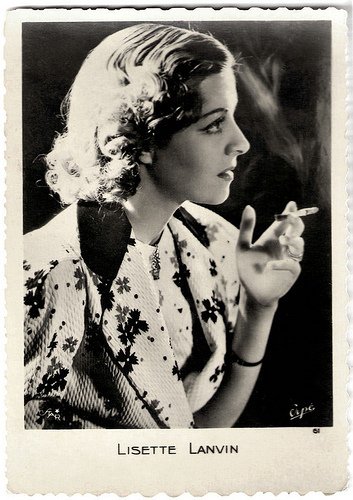
French postcard by Erpé, Paris, no. 61. Photo: Star.
Full of Surprises
Lisette Lanvin was born Elisabeth Etiennette Marie Caremil in Grasse, France in 1913. She was the daughter of Auguste Caremil, a cook, and Marie Ricorda. Less than two years later her father died in the war. With dreams of becoming an actress, Lanvin went to Paris. There she became a receptionist in a fashion house. In 1931, she landed a small role in the film operetta La Chauve-souris/Die Fledermaus/The Bat (Carl Lamac, 1931), based on the operetta by Johan Strauss jr. The film was co-produced with the German company Ondra-Lamac-Film created by director Lamas and his wife actress Anny Ondra. Ondra played the lead alongside Iván Petrovich. Her next film was Rouletabille aviateur/Rouletabille Aviator (1932). Caroline Hanotte at CinéArtistes : “Director was the Hungarian István Székely, better known under his Anglo-Saxon name Steve Sekely. He shot the film in his homeland where Roland Toutain, aka journalist Rouletabille spends his holidays. There he meets Lisette, daughter of Police Commissioner Bathory. The couple soon goes in search of gold bars stolen by gangsters. Far from being a masterpiece, the film is full of surprises. One can see the planes and Budapest in the thirties. The energy and bright smiles of the young heroes do the rest.” In 1932, Lanvin made five more films, including the thriller Le Chien jaune/The Yellow Dog (Jean Tarride, 1932) with Abel Tarride as Commissioner Maigret, Mon curé chez les riches/My pastor among the rich (Donatien, 1932) with Pauline Carton, and Je vous aimerai toujours/I Will Love You Always (Mario Camerini, Henri Decoin, 1932), again a leading role.
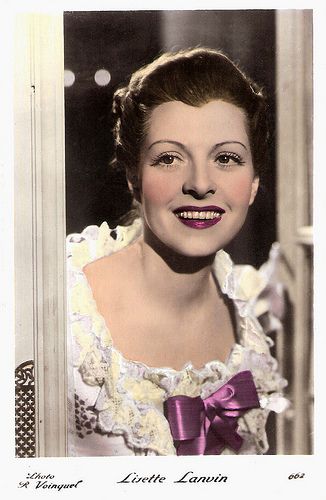
French postcard, no. 662. Photo: Raymond Voinquel.
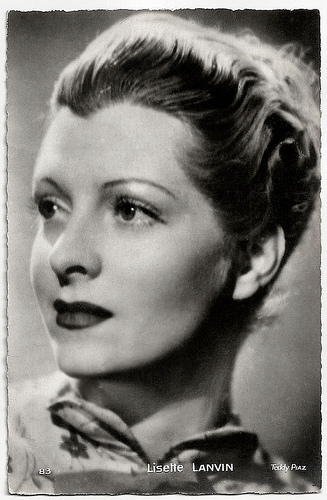
French postcard by Editions P.O., Paris, no. 83. Photo: Teddy Piaz.
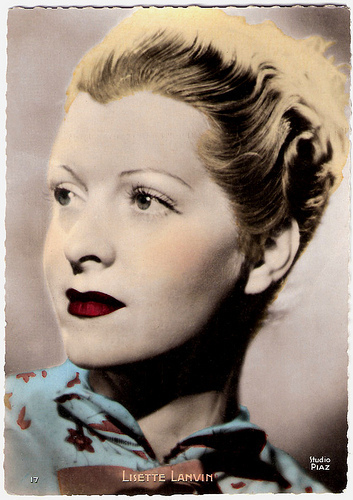
French postcard by Editions P.I., Paris, no. 17. Photo: Studio Piaz.
The Love Of Her Life
In the following years, Lisette Lanvin pursued a successful career with many comedies. Notable was Nitchevo (Jacques de Baroncelli, 1935), the name of a smuggling ship on which two naval officers (Harry Baur and Georges Rigaud) fall in love with the same woman. Then she played the daughter of the unsavoury Françoise Rosay in Jenny (Marcel Carné, 1936), who competes with her mother for the love of gangster Albert Prejean. By now, Lanvin had made a name for herself and Sacha Guitry gave her parts in Perles de la couronne/Pearls of the Crown (1937) and Remontons les Champs-Élysées/Go back to the Champs Elysées (1938). Lanvin also appeared in unpretentious comedies like Les Rois du sport/Kings of Sport (Pierre Colombier, 1937) alongside Raimu, Fernandel and Jules Berry, and she played the wife of Charles Boyer in Orage/Storm (Marc Allégret, 1938). In 1939, she played only in one film, La Brigade sauvage/Savage Brigade (Jean Dréville, Marcel L’Herbier, 1939). She played the daughter of Charles Vanel and Véra Korène in the Parisian milieu of Russian emigrants. In real life she became that year Mrs Guy Mortier. Her husband, a lieutenant with no connection to the film business, then mobilized. Guy Mortier would be the love of her life. During the war, Lanvin completely disappeared from the film scene. After the war she returned to make two more films. Her thirtieth and last feature was La Route inconnue/The Unknown Road (Léon Poirier, 1948) about life among the Tuareg of Charles de Foucauld (1858-1916), the future Catholic martyr and saint, played by Robert Darène. At 35, Lisette Lanvin decided to finish her career. In 2004, she died in Suresnes, France. She was 90.
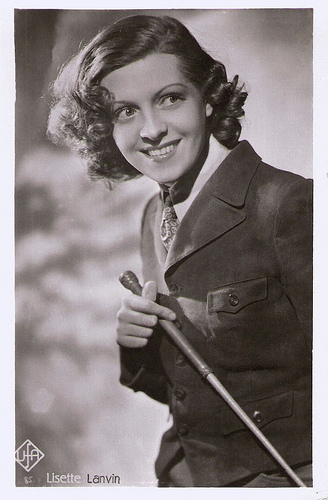
French postcard, Paris, no. 85. Photo: Ufa.
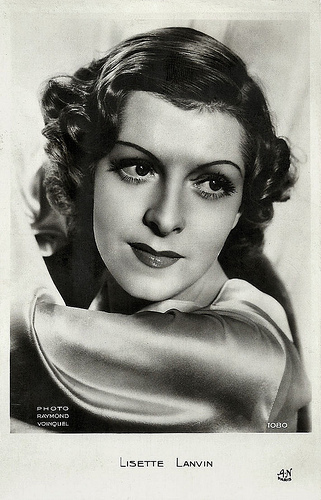
French postcard by A.N., Paris, no. 1080. Photo: Raymond Voinquel.
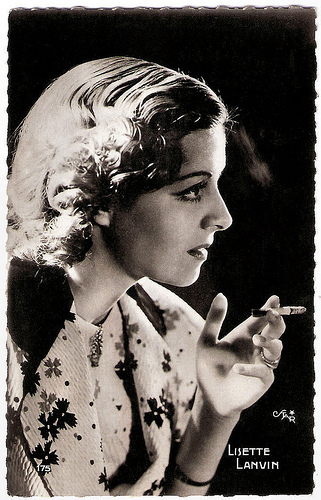
French postcard by Editions P.I., Paris, no. 175. Photo: Star.
Sources: Caroline Hanotte (CinéArtistes) (French), Philippe (CinéMémorial) (French), Films de France, AllMovie, Wikipedia (French) and

French postcard by Erpé, Paris, no. 61. Photo: Star.
Full of Surprises
Lisette Lanvin was born Elisabeth Etiennette Marie Caremil in Grasse, France in 1913. She was the daughter of Auguste Caremil, a cook, and Marie Ricorda. Less than two years later her father died in the war. With dreams of becoming an actress, Lanvin went to Paris. There she became a receptionist in a fashion house. In 1931, she landed a small role in the film operetta La Chauve-souris/Die Fledermaus/The Bat (Carl Lamac, 1931), based on the operetta by Johan Strauss jr. The film was co-produced with the German company Ondra-Lamac-Film created by director Lamas and his wife actress Anny Ondra. Ondra played the lead alongside Iván Petrovich. Her next film was Rouletabille aviateur/Rouletabille Aviator (1932). Caroline Hanotte at CinéArtistes : “Director was the Hungarian István Székely, better known under his Anglo-Saxon name Steve Sekely. He shot the film in his homeland where Roland Toutain, aka journalist Rouletabille spends his holidays. There he meets Lisette, daughter of Police Commissioner Bathory. The couple soon goes in search of gold bars stolen by gangsters. Far from being a masterpiece, the film is full of surprises. One can see the planes and Budapest in the thirties. The energy and bright smiles of the young heroes do the rest.” In 1932, Lanvin made five more films, including the thriller Le Chien jaune/The Yellow Dog (Jean Tarride, 1932) with Abel Tarride as Commissioner Maigret, Mon curé chez les riches/My pastor among the rich (Donatien, 1932) with Pauline Carton, and Je vous aimerai toujours/I Will Love You Always (Mario Camerini, Henri Decoin, 1932), again a leading role.

French postcard, no. 662. Photo: Raymond Voinquel.

French postcard by Editions P.O., Paris, no. 83. Photo: Teddy Piaz.

French postcard by Editions P.I., Paris, no. 17. Photo: Studio Piaz.
The Love Of Her Life
In the following years, Lisette Lanvin pursued a successful career with many comedies. Notable was Nitchevo (Jacques de Baroncelli, 1935), the name of a smuggling ship on which two naval officers (Harry Baur and Georges Rigaud) fall in love with the same woman. Then she played the daughter of the unsavoury Françoise Rosay in Jenny (Marcel Carné, 1936), who competes with her mother for the love of gangster Albert Prejean. By now, Lanvin had made a name for herself and Sacha Guitry gave her parts in Perles de la couronne/Pearls of the Crown (1937) and Remontons les Champs-Élysées/Go back to the Champs Elysées (1938). Lanvin also appeared in unpretentious comedies like Les Rois du sport/Kings of Sport (Pierre Colombier, 1937) alongside Raimu, Fernandel and Jules Berry, and she played the wife of Charles Boyer in Orage/Storm (Marc Allégret, 1938). In 1939, she played only in one film, La Brigade sauvage/Savage Brigade (Jean Dréville, Marcel L’Herbier, 1939). She played the daughter of Charles Vanel and Véra Korène in the Parisian milieu of Russian emigrants. In real life she became that year Mrs Guy Mortier. Her husband, a lieutenant with no connection to the film business, then mobilized. Guy Mortier would be the love of her life. During the war, Lanvin completely disappeared from the film scene. After the war she returned to make two more films. Her thirtieth and last feature was La Route inconnue/The Unknown Road (Léon Poirier, 1948) about life among the Tuareg of Charles de Foucauld (1858-1916), the future Catholic martyr and saint, played by Robert Darène. At 35, Lisette Lanvin decided to finish her career. In 2004, she died in Suresnes, France. She was 90.

French postcard, Paris, no. 85. Photo: Ufa.

French postcard by A.N., Paris, no. 1080. Photo: Raymond Voinquel.

French postcard by Editions P.I., Paris, no. 175. Photo: Star.
Sources: Caroline Hanotte (CinéArtistes) (French), Philippe (CinéMémorial) (French), Films de France, AllMovie, Wikipedia (French) and
Published on July 12, 2013 02:06
July 10, 2013
Pascale Petit
In the late 1950s, sweet and sexy French actress Pascale Petit (1938) formed serious competition for Brigitte Bardot as The Sex Symbol of the French cinema.
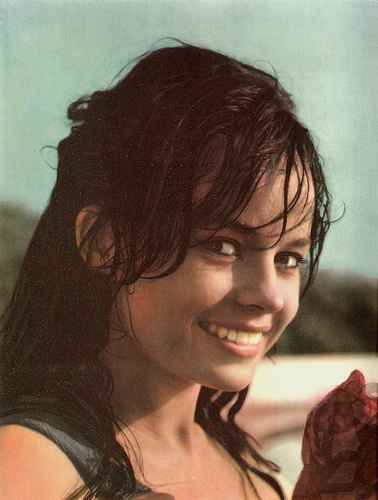
Vintage postcard.
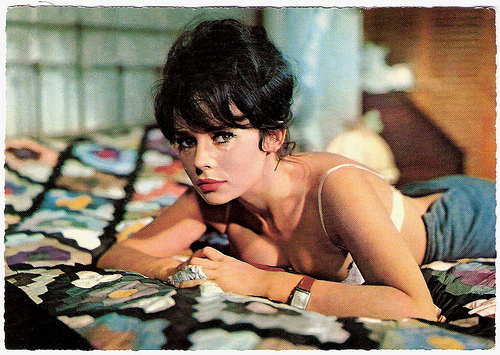 German postcard by Krüger, no. 902/65.
German postcard by Krüger, no. 902/65.
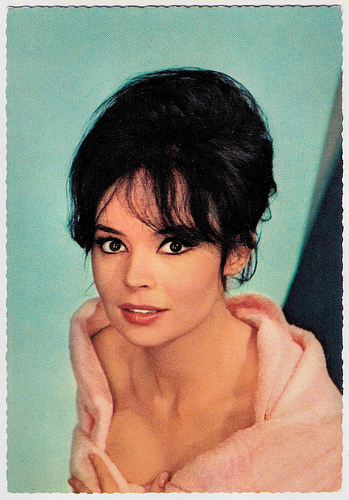
German postcard by Krüger, no. 902/90. Photo: Sam Lévin.
Seductive Femme Fatale
Pascale Petit was born as Anne-Marie Petit in Paris, France in 1938. Before becoming an actress, she worked as a beautician. Her cinema debut was in Les Sorcières de Salem/The Crucible (Raymond Rouleau, 1957) starring Yves Montand and Simone Signoret. Famous author Jean-Paul Sartre wrote the screenplay, based on the play by Arthur Miller. The following year, Pascale Petit's role as a rich, existentialist kid in Les tricheurs/The Cheaters (Marcel Carné, 1958) made her a star. A scene in which one of her breasts was shown caused a sensation. Hal Erickson notes at AllMovie : "Of the cast, Pascale Petit stands out as a trendy young girl whose willingness to follow the crowd leads to tragedy." She won the prestigious Prix Suzanne Bianchetti in 1958 as the most promising French actress, and soon more roles as a seductive femme fatale followed.
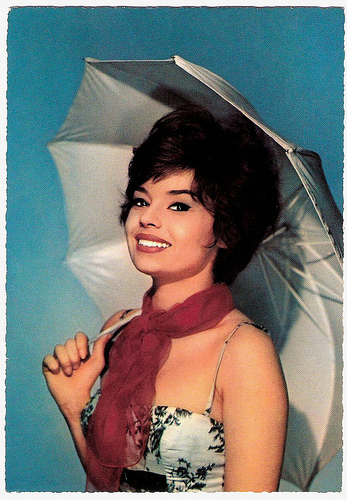
German postcard by Krüger, no. 902/89. Photo: Sam Levin.
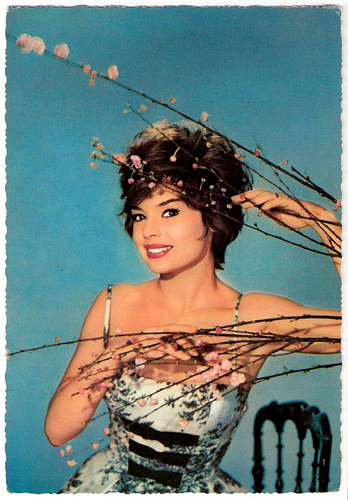
German postcard by Krüger, no. 902/88. Photo: Sam Lévin.
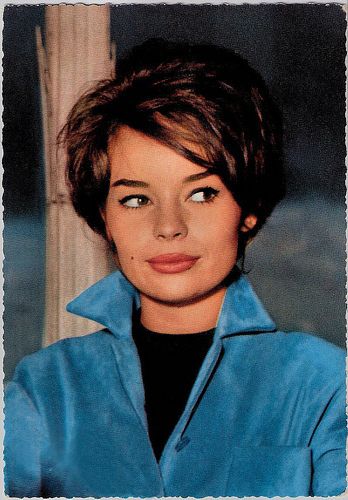
German postcard by Krüger, no. 902/160. Photo: Fried Agency / Ufa.
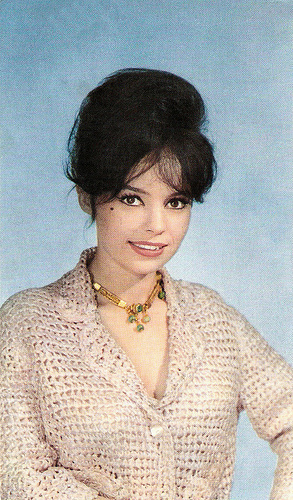
French postcard by PSG, no. 33, offered by Corvisart. Photo: Lucienne Chevert.
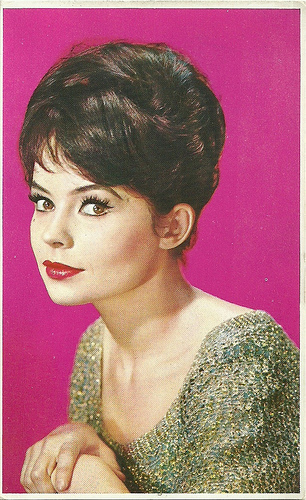
French postcard by Editions P.I., Paris, no. 1067, offered by Corvisart, Epinal. Photo: Sam Lévin.
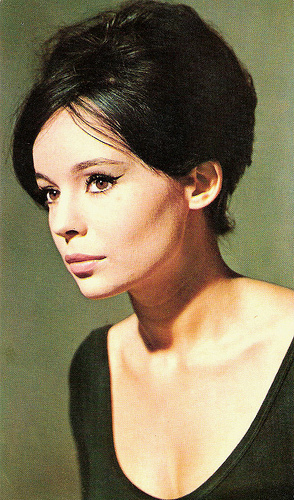
French postcard by PSG, no. 70, offered by Corvisart. Photo: Sam Lévin.
German and Italian B pictures
Pascale Petit played in such comedies as Faibles femmes/Three Murderesses (Michel Boisrond, 1959) with Alain Delon and Mylène Demongeot, and Une fille pour l'été/A girl for the Summer (Edouard Molinaro, 1960) opposite Micheline Presle. For a while the media compared her to Brigitte Bardot. In 1959 PP married poet and actor Giani Esposito and followed him to Italy. In the 1960s she was mainly seen in German and Italian B pictures, such as the Spaghetti Western Joe... cercati un posto per morire!/Find a Place to Die (Giuliano Carnimeo, 1968) with Jeffrey Hunter. In 1969 she divorced Esposito and married actor Ray Denton, her co-star of the spy thriller Corrida pour un espion/Code Name: Jaguar (Maurice Labro, 1965).
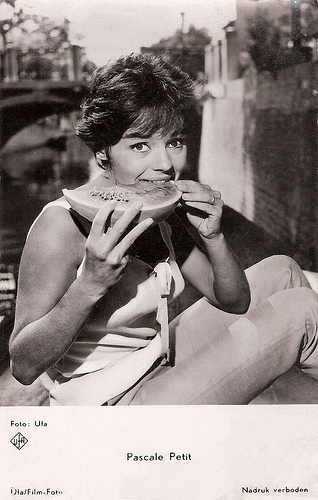
Dutch postcard by Gebr. Spanjersberg N.V., Rotterdam, no. 1239. Photo: Ufa, Berlin-Tempelhof.
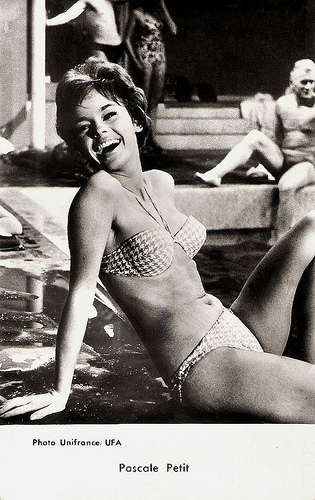
French postcard by Editions P.I., Paris, no. FK 29. Photo: Unifrance / Ufa.
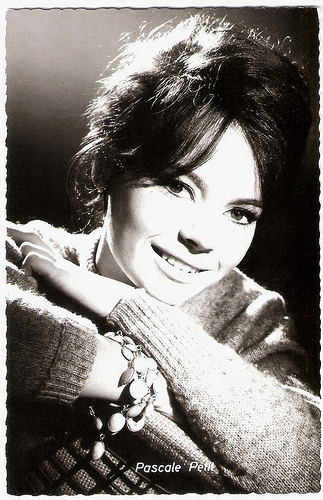
German postcard by Kolibri-Verlag, Minden/Westf., no. 1295.
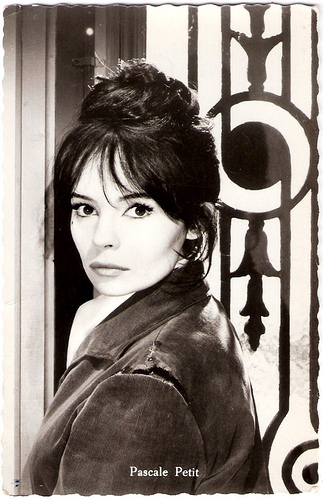
Dutch postcard, ca. 1961.
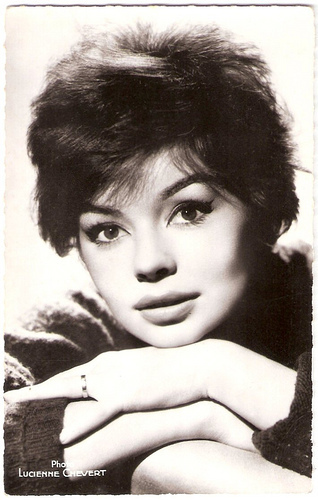
French postcard by Editions du Globe, Paris, no. 807. Photo: Lucienne Chevert.
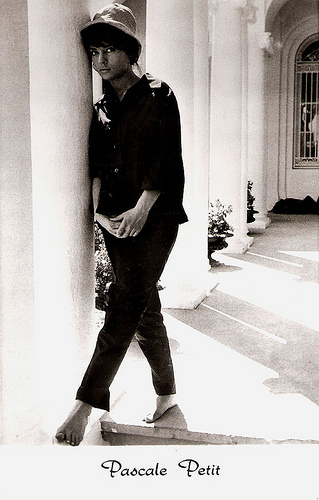
Dutch postcard by Gebr. Spanjersberg, Rotterdam, no. 5543.
Delicious Dutch Gem
In the early 1970s Pascale Petit tried to make a comeback in France, as well in the cinema with Chronique d'un Couple.../Chronicle of a Couple (Roger Coggio, 1971) as in the music scene with Il ne reste que moi.../What's Left is Me (1973). The success was lukewarm and in the following decades she worked as a character actress in unremarkable international films and TV productions. Interesting were a small, delicious Dutch gem, A Strange Love Affair (Eric De Kuyper, Paul Verstraten, 1984), and two TV films by Brigitte Bardot's Svengali - Roger Vadim, the mini-series La nouvelle tribu/The new tribe (1996), and Un coup de baguette magique/A magic wand (1997), both featuring Marie-Christine Barrault. Pascale Petit has a daughter, Douchka, from her marriage with Giani Esposito.
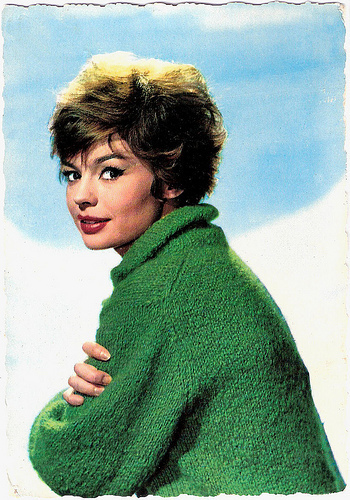
French postcard by E.D.U.G., no. 64. Photo: Sam Lévin.
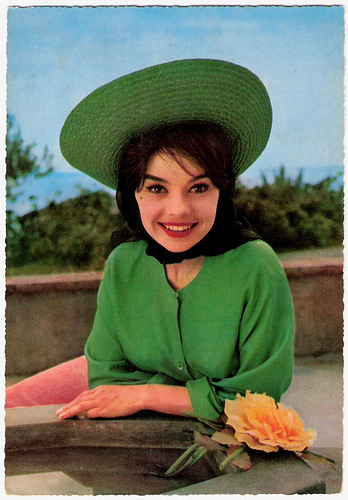
German postcard by Krüger, no. 902/44.
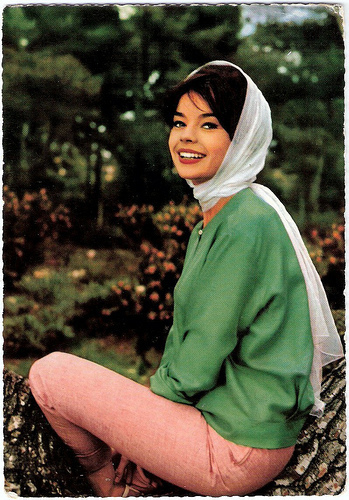
German postcard by Krüger, ca. 1961.
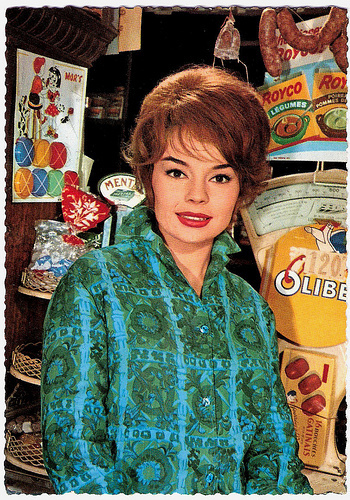
German postcard by Krüger, no. 902/134. Photo: Ufa.
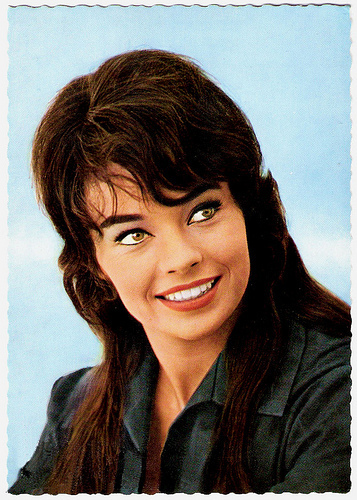
German postcard by Ufa, Berlin-Tempelhof, no. CK 341. Retail price: 30 Pfg. Photo: Gérard Decaux / Ufa.
Scene from Les Tricheurs with Jean-Paul Belmondo and Pascale Petit.
Sources: Hal Erickson (AllMovie), AllMovie, Wikipedia and

Vintage postcard.
 German postcard by Krüger, no. 902/65.
German postcard by Krüger, no. 902/65.
German postcard by Krüger, no. 902/90. Photo: Sam Lévin.
Seductive Femme Fatale
Pascale Petit was born as Anne-Marie Petit in Paris, France in 1938. Before becoming an actress, she worked as a beautician. Her cinema debut was in Les Sorcières de Salem/The Crucible (Raymond Rouleau, 1957) starring Yves Montand and Simone Signoret. Famous author Jean-Paul Sartre wrote the screenplay, based on the play by Arthur Miller. The following year, Pascale Petit's role as a rich, existentialist kid in Les tricheurs/The Cheaters (Marcel Carné, 1958) made her a star. A scene in which one of her breasts was shown caused a sensation. Hal Erickson notes at AllMovie : "Of the cast, Pascale Petit stands out as a trendy young girl whose willingness to follow the crowd leads to tragedy." She won the prestigious Prix Suzanne Bianchetti in 1958 as the most promising French actress, and soon more roles as a seductive femme fatale followed.

German postcard by Krüger, no. 902/89. Photo: Sam Levin.

German postcard by Krüger, no. 902/88. Photo: Sam Lévin.

German postcard by Krüger, no. 902/160. Photo: Fried Agency / Ufa.

French postcard by PSG, no. 33, offered by Corvisart. Photo: Lucienne Chevert.

French postcard by Editions P.I., Paris, no. 1067, offered by Corvisart, Epinal. Photo: Sam Lévin.

French postcard by PSG, no. 70, offered by Corvisart. Photo: Sam Lévin.
German and Italian B pictures
Pascale Petit played in such comedies as Faibles femmes/Three Murderesses (Michel Boisrond, 1959) with Alain Delon and Mylène Demongeot, and Une fille pour l'été/A girl for the Summer (Edouard Molinaro, 1960) opposite Micheline Presle. For a while the media compared her to Brigitte Bardot. In 1959 PP married poet and actor Giani Esposito and followed him to Italy. In the 1960s she was mainly seen in German and Italian B pictures, such as the Spaghetti Western Joe... cercati un posto per morire!/Find a Place to Die (Giuliano Carnimeo, 1968) with Jeffrey Hunter. In 1969 she divorced Esposito and married actor Ray Denton, her co-star of the spy thriller Corrida pour un espion/Code Name: Jaguar (Maurice Labro, 1965).

Dutch postcard by Gebr. Spanjersberg N.V., Rotterdam, no. 1239. Photo: Ufa, Berlin-Tempelhof.

French postcard by Editions P.I., Paris, no. FK 29. Photo: Unifrance / Ufa.

German postcard by Kolibri-Verlag, Minden/Westf., no. 1295.

Dutch postcard, ca. 1961.

French postcard by Editions du Globe, Paris, no. 807. Photo: Lucienne Chevert.

Dutch postcard by Gebr. Spanjersberg, Rotterdam, no. 5543.
Delicious Dutch Gem
In the early 1970s Pascale Petit tried to make a comeback in France, as well in the cinema with Chronique d'un Couple.../Chronicle of a Couple (Roger Coggio, 1971) as in the music scene with Il ne reste que moi.../What's Left is Me (1973). The success was lukewarm and in the following decades she worked as a character actress in unremarkable international films and TV productions. Interesting were a small, delicious Dutch gem, A Strange Love Affair (Eric De Kuyper, Paul Verstraten, 1984), and two TV films by Brigitte Bardot's Svengali - Roger Vadim, the mini-series La nouvelle tribu/The new tribe (1996), and Un coup de baguette magique/A magic wand (1997), both featuring Marie-Christine Barrault. Pascale Petit has a daughter, Douchka, from her marriage with Giani Esposito.

French postcard by E.D.U.G., no. 64. Photo: Sam Lévin.

German postcard by Krüger, no. 902/44.

German postcard by Krüger, ca. 1961.

German postcard by Krüger, no. 902/134. Photo: Ufa.

German postcard by Ufa, Berlin-Tempelhof, no. CK 341. Retail price: 30 Pfg. Photo: Gérard Decaux / Ufa.
Scene from Les Tricheurs with Jean-Paul Belmondo and Pascale Petit.
Sources: Hal Erickson (AllMovie), AllMovie, Wikipedia and
Published on July 10, 2013 23:00
July 9, 2013
Amleto
The Italian silent production Amleto/Hamlet (Eleuterio Rodolfi, 1917) is one of two hundred or more Shakespeare films that were made in the silent period of cinema. Film historian Luke McKernan introduced a screening of the film at the Notre Dame Shakespeare Festival in 2004: "it is a good and interesting film. Not a great film, but arguably the best silent Shakespeare film that exists."
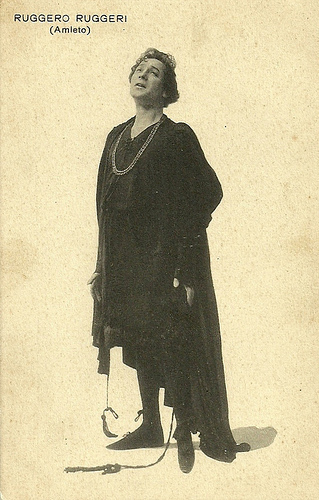
Italian postcard, no. 8067. Photo: Ruggero Ruggeri as Hamlet/Amleto, either on stage or in the film Amleto (Eleuterio Rodolfi, 1917).
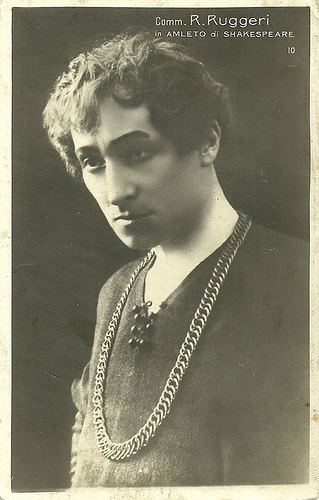
Italian postcard. Editor unknown.
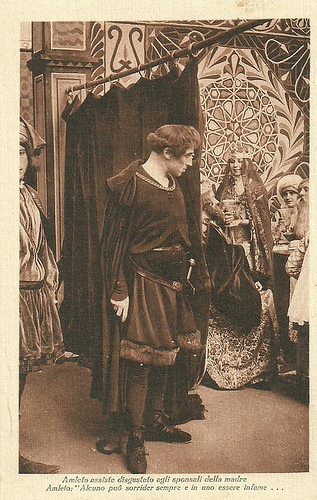
Italian postcard. Ruggero Ruggeri as Hamlet and Mercedes Brignone as Queen Gertrude in Amleto/Hamlet (Eleuterio Rodolfi, 1917). Caption: "Disgusted Hamlet assists to the wedding of his mother. Hamlet: 'That one may smile, and smile, and be a villain.'" (Though these are Shakespeare's words, in the play however, Gertrude is already remarried.)
Triumph
The title role of Amleto/Hamlet was played by Ruggero Ruggeri, one the most important Italian actors of the first half of the twentieth century. Before making the film, he had already triumphed in a stage production of Hamlet. Amleto was his third film. Helena Makowska played Ophelia, and Mercedes Brignone, who is particularly good in the film, played Gertude. Armand Pouget was the Ghost of Hamlet’s father, Gerardo Pena played Laertes, and Martelli played Claudius. The film was released in Italy, and after the war also in France, Britain and the US. Luke McKernan: "Amleto made under economic circumstances very different to the pre-war period when Italian epics conquered the world cinema market. It is an altogether more modest production; though not an impoverished one as such. It is certainly a film that needs to be much better known."
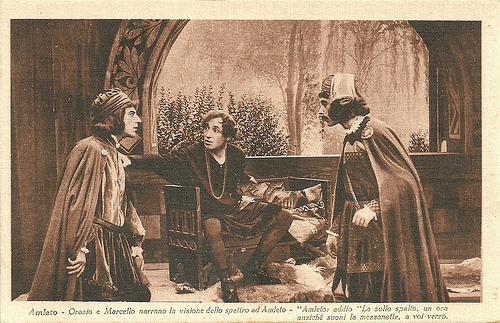
Italian postcard. Ruggero Ruggeri as Hamlet in Amleto/Hamlet (Eleuterio Rodolfi, 1917). Translation caption: "Horatio and Marcellus tell Hamlet of their vision of the ghost. Hamlet responds (Shakespeare's words): 'Upon the platform, 'twixt eleven and twelve, I'll visit you.'"
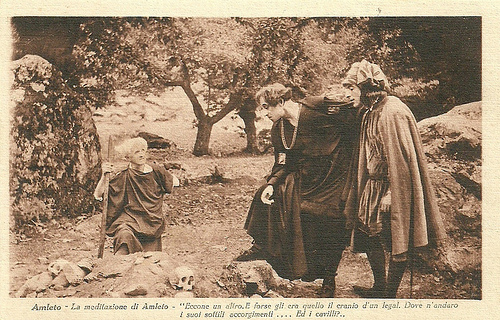
Italian postcard. Ruggero Ruggeri as Hamlet in Amleto/Hamlet (Eleuterio Rodolfi, 1917). Caption: "Hamlet's meditation: 'There's another: why may not that be the skull of a lawyer? Where be his quiddities now, his quillets, his cases, his tenures, and his tricks?'"
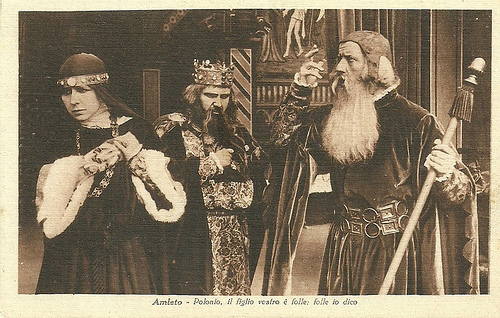
Italian postcard. Mercedes Brignone as Queen Gertrude and Armand Pouget as King Claudius in Amleto/Hamlet (Eleuterio Rodolfi, 1917). Caption: "Polonius: 'Your noble son is mad. Mad call I it.'"
Sources: Luke McKernan, and IMDb.

Italian postcard, no. 8067. Photo: Ruggero Ruggeri as Hamlet/Amleto, either on stage or in the film Amleto (Eleuterio Rodolfi, 1917).

Italian postcard. Editor unknown.

Italian postcard. Ruggero Ruggeri as Hamlet and Mercedes Brignone as Queen Gertrude in Amleto/Hamlet (Eleuterio Rodolfi, 1917). Caption: "Disgusted Hamlet assists to the wedding of his mother. Hamlet: 'That one may smile, and smile, and be a villain.'" (Though these are Shakespeare's words, in the play however, Gertrude is already remarried.)
Triumph
The title role of Amleto/Hamlet was played by Ruggero Ruggeri, one the most important Italian actors of the first half of the twentieth century. Before making the film, he had already triumphed in a stage production of Hamlet. Amleto was his third film. Helena Makowska played Ophelia, and Mercedes Brignone, who is particularly good in the film, played Gertude. Armand Pouget was the Ghost of Hamlet’s father, Gerardo Pena played Laertes, and Martelli played Claudius. The film was released in Italy, and after the war also in France, Britain and the US. Luke McKernan: "Amleto made under economic circumstances very different to the pre-war period when Italian epics conquered the world cinema market. It is an altogether more modest production; though not an impoverished one as such. It is certainly a film that needs to be much better known."

Italian postcard. Ruggero Ruggeri as Hamlet in Amleto/Hamlet (Eleuterio Rodolfi, 1917). Translation caption: "Horatio and Marcellus tell Hamlet of their vision of the ghost. Hamlet responds (Shakespeare's words): 'Upon the platform, 'twixt eleven and twelve, I'll visit you.'"

Italian postcard. Ruggero Ruggeri as Hamlet in Amleto/Hamlet (Eleuterio Rodolfi, 1917). Caption: "Hamlet's meditation: 'There's another: why may not that be the skull of a lawyer? Where be his quiddities now, his quillets, his cases, his tenures, and his tricks?'"

Italian postcard. Mercedes Brignone as Queen Gertrude and Armand Pouget as King Claudius in Amleto/Hamlet (Eleuterio Rodolfi, 1917). Caption: "Polonius: 'Your noble son is mad. Mad call I it.'"
Sources: Luke McKernan, and IMDb.
Published on July 09, 2013 23:00
July 8, 2013
John Loder
Tall and handsome John Loder (1898-1988) was best known for wearing tweeds and smoking a pipe in his roles. The British-American actor started his film career as an extra in the German silent cinema, and later worked as a leading man both in Great Britain and in Hollywood.
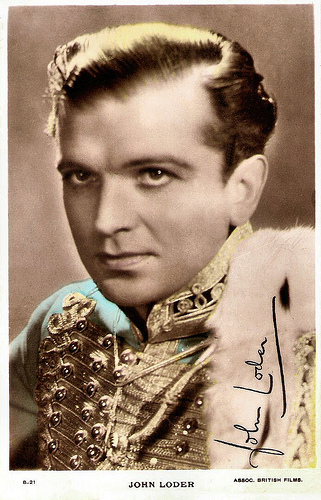
British postcard by Real Photograph, no. B 21. Photo: Assoc. British Films.
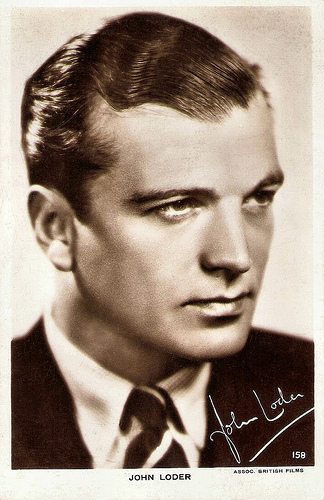
British postcard by Real Photograph, no. 158. Photo: Assoc. British Films.
Popular Heartthrob
John Loder was born William John Muir Lowe in London in 1898. His father was General W. H. M. Lowe, the British officer to whom Patrick Pearse, the lead rebel of the 1916 Easter Rising in Dublin, Ireland, surrendered. John was educated at the prestigious Eton college and at the Royal Military College. He followed his father into the army, being commissioned into 15th Hussars as a second lieutenant in 1915, and then served in the Gallipoli Campaign. In France, he was engaged in the Battle of the Somme and was taken prisoner by the Germans in 1918 and brought to a prisoner-of-war camp in Germany. After leaving the cavalry he established a pickle factory in Potsdam. Loder also began to develop an interest in acting. He appeared in bit-parts in a few silent German films at the Tempelhof Film Studios, employed by Alexander Korda. Examples are the comedy Der Tänzer meiner Frau/Dancing Mad (Alexander Korda, 1925) starring Victor Varconi and María Corda, and Madame wünscht keine Kinder/Madame Wants No Children (Alexander Korda, 1926) starring María Corda and Harry Liedtke. He had bigger roles in Die weiße Spinne/The White Spider (Carl Boese, 1927) with Maria Paudler, and the horror fantasy Alraune/Mandrake (Henrik Galeen, 1928) starring Brigitte Helm. Loder returned to England, where he played a big role in the silent drama The First Born (Miles Mander, 1928) starring Madeleine Carroll. It was made by Gainsborough Pictures at their Elstree Studios. Talkies had become the new rage and Loder tried his luck in Hollywood. He appeared in The Doctor's Secret (William C. De Mille, 1929), which was Paramount's first talking picture. He was also in Rin-Tin-Tin's first sound picture, in 1930. Gary Brumburgh at IMDb : “although the ‘veddy British’ actor seemed to show promise, his persona was a bit too cut and dried for American tastes. Gaining little ground as a leading man there, Loder eventually returned to England“. He played a supporting part in Hitchcock’s second sound film, Juno and the Paycock (Alfred Hitchcock, 1930) and another in the historical comedy The Private Life of Henry VIII (Alexander Korda, 1933) starring Charles Laughton as Henry VIII, King of England. He became a popular heartthrob with such plush musicals as Love Life and Laughter (Maurice Elvey, 1934) with Gracie Fields. He co-starred with Sylvia Sidney and Oscar Homolka in Hitchcock’s thriller Sabotage (Alfred Hitchcock, 1936), based on Joseph Conrad's novel The Secret Agent. Loder was also the male romantic interest in the original King Solomon's Mines (Robert Stevenson, 1937), the first film adaptation of the novel by Henry Rider Haggard.
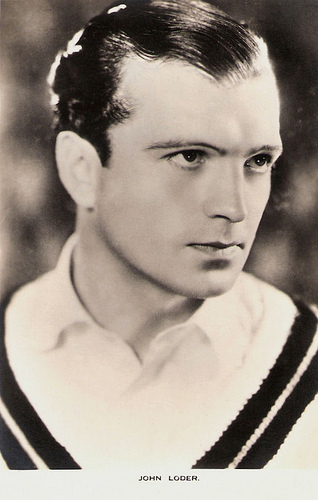
British postcard in the Film Weekly Series, London.
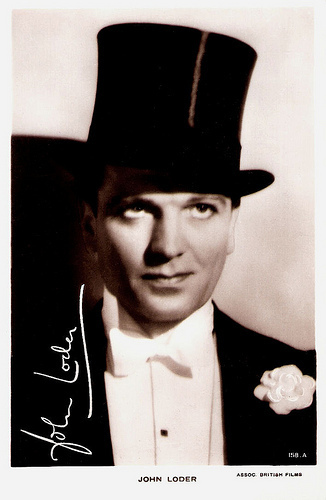
British postcard by Real Photograph, London, no. 158 A. Photo: Gaumont-British.
A Career in B Movies
When World War II started, John Loder returned to America. In Hollywood he seamlessly coasted into a career in B movies, usually playing aristocrats. Occasionally he played supporting parts in major A films such as How Green Was My Valley (John Ford, 1941), Now, Voyager (Irving Rapper, 1942) with Bette Davis, and Passage to Marseille (Michael Curtiz, 1944) starring Humphrey Bogart. In Hollywood, Loder never attained the star status he had enjoyed in Britain during the 1930s. He was married five times. His first wife was Sophie Kabel, with whom he had a son. Two of his wives were actresses: French actress Micheline Cheirel (1936–1941), with whom he had a daughter, and Hollywood love goddess Hedy Lamarr (1943–1947). With Lamarr, he had two children, Denise (1945) and Anthony (1947), and adopted Lamarr's son James Markey from her previous marriage to screenwriter Gene Markey. He co-starred with her in the American crime drama Dishonored Lady (Robert Stevenson, 1947), which Lamarr produced. He also appeared on Broadway in 1947 and 1950. In 1947 he became an American citizen, and two years later, he married wife no. four, Evelyn Auff Mordt (1949-1955). Incidentally he appeared in films, like Gideon's Day (John Ford, 1958) featuring Jack Hawkins. In 1958, he also wed his final wife, Argentine heiress Alba Julia Lagomarsino, and Loder semi-retired. He lived on her 25,000 acre cattle ranch, and spent much time at the Jockey Club in Buenos Aires. In 1959 he became a naturalised citizen of the United Kingdom as he had been of ‘uncertain nationality’. His last screen appearance was in the British crime film The Firechasers (Sidney Hayers, 1971) starring Chad Everett. After divorcing his fifth wife in 1972, Loder returned to London and resided for some years in a house opposite Harrods. His general health deteriorated in his eighties and he was admitted in 1982 to the Distressed Gentlefolks Aid Association's Nursing Home in Kensington, where he was well looked after, venturing out by taxi once a week to his Club for luncheons. John Loder eventually died in London, aged 90 in 1988. His autobiography, Hollywood Hussar was published in 1977.
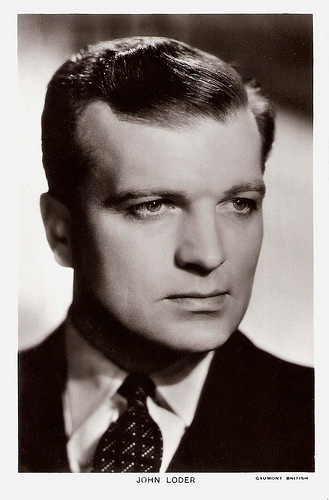
British postcard by Real Photograph in the Picturegoer Series, London, no. 419c. Photo: Gaumont-British.
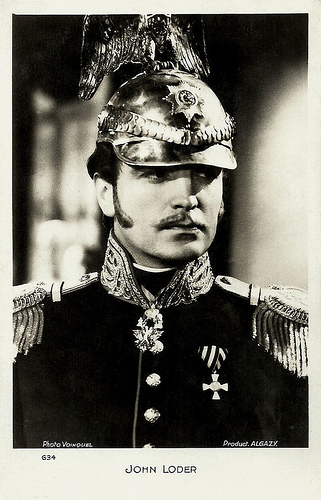
French postcard by Algazy, no. 634. Photo: Voinquel. Probably a card for Maurice Tourneur's period piece Katia (1938), in which the Russian Czar Alexander II (Loder) turns his mistress Katia (Danielle Darrieux) into a princess, which eventually leads to his assassination.
Sources:

British postcard by Real Photograph, no. B 21. Photo: Assoc. British Films.

British postcard by Real Photograph, no. 158. Photo: Assoc. British Films.
Popular Heartthrob
John Loder was born William John Muir Lowe in London in 1898. His father was General W. H. M. Lowe, the British officer to whom Patrick Pearse, the lead rebel of the 1916 Easter Rising in Dublin, Ireland, surrendered. John was educated at the prestigious Eton college and at the Royal Military College. He followed his father into the army, being commissioned into 15th Hussars as a second lieutenant in 1915, and then served in the Gallipoli Campaign. In France, he was engaged in the Battle of the Somme and was taken prisoner by the Germans in 1918 and brought to a prisoner-of-war camp in Germany. After leaving the cavalry he established a pickle factory in Potsdam. Loder also began to develop an interest in acting. He appeared in bit-parts in a few silent German films at the Tempelhof Film Studios, employed by Alexander Korda. Examples are the comedy Der Tänzer meiner Frau/Dancing Mad (Alexander Korda, 1925) starring Victor Varconi and María Corda, and Madame wünscht keine Kinder/Madame Wants No Children (Alexander Korda, 1926) starring María Corda and Harry Liedtke. He had bigger roles in Die weiße Spinne/The White Spider (Carl Boese, 1927) with Maria Paudler, and the horror fantasy Alraune/Mandrake (Henrik Galeen, 1928) starring Brigitte Helm. Loder returned to England, where he played a big role in the silent drama The First Born (Miles Mander, 1928) starring Madeleine Carroll. It was made by Gainsborough Pictures at their Elstree Studios. Talkies had become the new rage and Loder tried his luck in Hollywood. He appeared in The Doctor's Secret (William C. De Mille, 1929), which was Paramount's first talking picture. He was also in Rin-Tin-Tin's first sound picture, in 1930. Gary Brumburgh at IMDb : “although the ‘veddy British’ actor seemed to show promise, his persona was a bit too cut and dried for American tastes. Gaining little ground as a leading man there, Loder eventually returned to England“. He played a supporting part in Hitchcock’s second sound film, Juno and the Paycock (Alfred Hitchcock, 1930) and another in the historical comedy The Private Life of Henry VIII (Alexander Korda, 1933) starring Charles Laughton as Henry VIII, King of England. He became a popular heartthrob with such plush musicals as Love Life and Laughter (Maurice Elvey, 1934) with Gracie Fields. He co-starred with Sylvia Sidney and Oscar Homolka in Hitchcock’s thriller Sabotage (Alfred Hitchcock, 1936), based on Joseph Conrad's novel The Secret Agent. Loder was also the male romantic interest in the original King Solomon's Mines (Robert Stevenson, 1937), the first film adaptation of the novel by Henry Rider Haggard.

British postcard in the Film Weekly Series, London.

British postcard by Real Photograph, London, no. 158 A. Photo: Gaumont-British.
A Career in B Movies
When World War II started, John Loder returned to America. In Hollywood he seamlessly coasted into a career in B movies, usually playing aristocrats. Occasionally he played supporting parts in major A films such as How Green Was My Valley (John Ford, 1941), Now, Voyager (Irving Rapper, 1942) with Bette Davis, and Passage to Marseille (Michael Curtiz, 1944) starring Humphrey Bogart. In Hollywood, Loder never attained the star status he had enjoyed in Britain during the 1930s. He was married five times. His first wife was Sophie Kabel, with whom he had a son. Two of his wives were actresses: French actress Micheline Cheirel (1936–1941), with whom he had a daughter, and Hollywood love goddess Hedy Lamarr (1943–1947). With Lamarr, he had two children, Denise (1945) and Anthony (1947), and adopted Lamarr's son James Markey from her previous marriage to screenwriter Gene Markey. He co-starred with her in the American crime drama Dishonored Lady (Robert Stevenson, 1947), which Lamarr produced. He also appeared on Broadway in 1947 and 1950. In 1947 he became an American citizen, and two years later, he married wife no. four, Evelyn Auff Mordt (1949-1955). Incidentally he appeared in films, like Gideon's Day (John Ford, 1958) featuring Jack Hawkins. In 1958, he also wed his final wife, Argentine heiress Alba Julia Lagomarsino, and Loder semi-retired. He lived on her 25,000 acre cattle ranch, and spent much time at the Jockey Club in Buenos Aires. In 1959 he became a naturalised citizen of the United Kingdom as he had been of ‘uncertain nationality’. His last screen appearance was in the British crime film The Firechasers (Sidney Hayers, 1971) starring Chad Everett. After divorcing his fifth wife in 1972, Loder returned to London and resided for some years in a house opposite Harrods. His general health deteriorated in his eighties and he was admitted in 1982 to the Distressed Gentlefolks Aid Association's Nursing Home in Kensington, where he was well looked after, venturing out by taxi once a week to his Club for luncheons. John Loder eventually died in London, aged 90 in 1988. His autobiography, Hollywood Hussar was published in 1977.

British postcard by Real Photograph in the Picturegoer Series, London, no. 419c. Photo: Gaumont-British.

French postcard by Algazy, no. 634. Photo: Voinquel. Probably a card for Maurice Tourneur's period piece Katia (1938), in which the Russian Czar Alexander II (Loder) turns his mistress Katia (Danielle Darrieux) into a princess, which eventually leads to his assassination.
Sources:
Published on July 08, 2013 23:00
July 7, 2013
Jean-Paul Belmondo
One of our favorite French stars is Jean-Paul Belmondo (1933). Bébel was a big comedy and action star in Europe from the mid-1960s till the mid-1980s, but he was initially associated with the Nouvelle Vague, the French New Wave of the 1960s. Despite his unconventional looks, including a broken nose, he was often polled as one of the sexiest men in the world. For some 50 years he now remains one of the most popular and best-loved personalities in France.
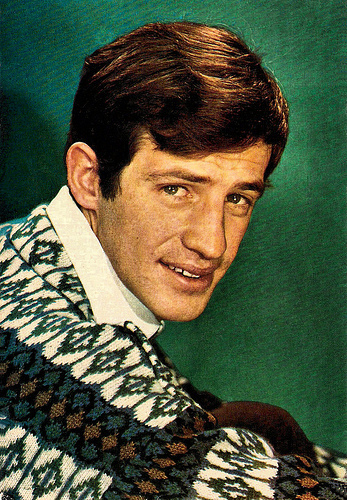
Spanish postcard by Oscarcolor, Barcelona, no. 83, 1964. Photo: Sam Lévin.
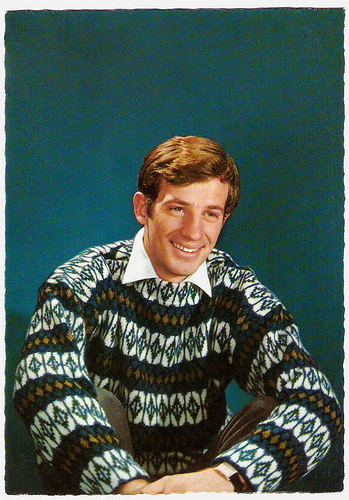
French postcard by E.D.U.G., no. 160. Photo: Sam Lévin.

Italian postcard in the series Artisti di sempre by Rotalfoto, Milano, no. 355.
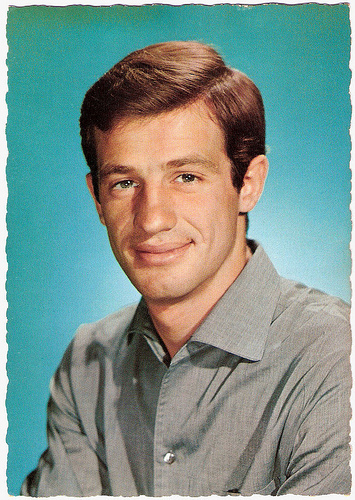
French postcard by E.D.U.G., no. 77. Photo: Lucienne Chevert.
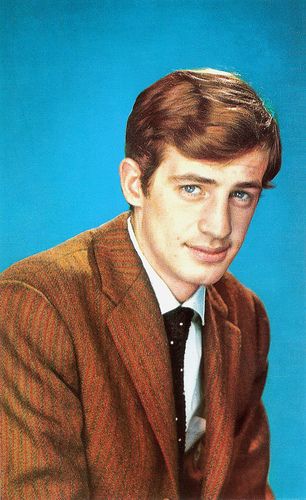
French postcard by Editions P.I., Paris, no. 1065, presented by Corvisart, Epinal. Photo: Sam Lévin.
Bébel
Jean-Paul Belmondo was born in Neuilly-sur-Seine, a commune in the western suburbs of Paris, in 1933. He is the son of Paul Belmondo, a sculptor of Sicilian descent. Young Jean-Paul did not perform well at school, but developed a passion for boxing before he decided that his future lay in acting. After a number of attempts, he finally gained admittance to the Paris Conservatoire in 1952, although his tutors were not overly optimistic about his prospects. It was here that he acquired the nickname 'Bébel'. In the mid-1950s, he appeared in a few theatrical productions, often to great acclaim, before beginning a film career in 1956 with Les Copains du dimanche/The Sunday Friends (Henry Aisner, 1956-1958). The film was never played in public cinemas though and his episodes in À pied, à cheval et en voiture/On Foot, on Horse, and on Wheels (Maurice Delbez, 1957) were even cut before release, but soon bigger roles followed in the spoof thriller Sois Belle et Tais-Toi/Be Beautiful But Shut Up (Marc Allégret, 1957) - his first co-starring role with Alain Delon, the hit Les Tricheurs/The Cheaters (Marcel Carné, 1958) and À double tour/Web of Passion (Claude Chabrol, 1959) with Madeleine Robinson. It was in 1958 that the 25-year-old Belmondo attracted the attention of a former critic turned filmmaker Jean-Luc Godard. The latter was impressed by the actor’s spontaneity and cast him first in a quirky short, Charlotte et son Jules (1959).
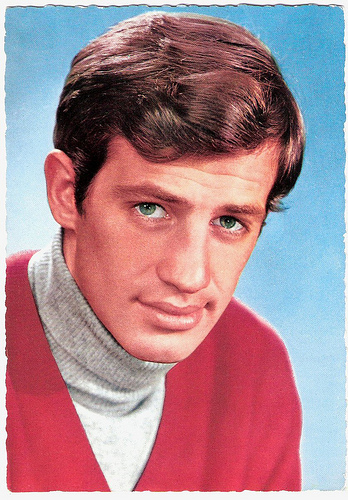
French postcard by E.D.U.G., nr. 233. Photo: Sam Lévin.

French postcard by E.D.U.G., nr. 78. Photo: Lucienne Chevert.
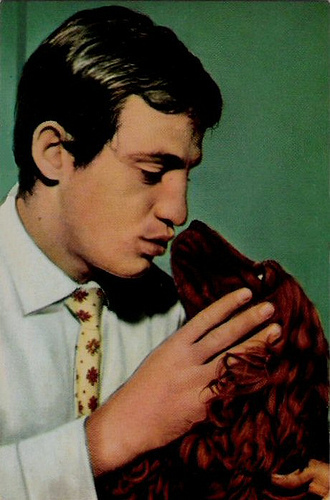
Belgian collector's card, nr. 30.

Romanian postcard by Casa Filmului Acin. Photo: Sam Lévin.

French postcard by Editions P.I., no. 1136. Photo: Sam Lévin.
Breathless
Stardom came in 1959 when Jean-Paul Belmondo took the lead role of a sympathetic gangster in Godard’s landmark feature debut A Bout de souffle/Breathless (Jean-Luc Godard, 1960). At AllMovie , Lucia Bozzola writes: "Belmondo perfectly embodied the cool youthful rebellion guiding Godard's trailblazing cinematic style, rendering Belmondo the Gallic James Dean and heir apparent to Michel Simon and Jean Gabin." This film launched not just Belmondo’s film career but also the Nouvelle Vague , the New Wave of the French cinema. Belmondo would play a major part in the Nouvelle Vague during the early 1960s with roles in e.g. Une femme est une femme/A Woman Is a Woman (Jean-Luc Godard, 1961) and Pierrot le fou/Pierrot Goes Wild (Jean-Luc Godard, 1965). Besides these classics he also acted in a stream of other excellent films: Classe tous risques/The Big Risk (Claude Sautet, 1960) with Lino Ventura, Moderato cantabile/Seven Days... Seven Nights (Peter Brook, 1960), La Ciociara/Two Women (Vittorio De Sica, 1960) with Sophia Loren, and La Viaccia/The Lovemakers (Mauro Bolognini, 1961) with Claudia Cardinale. He played a priest in the dark World War II drama Léon Morin, prêtre/Leon Morin, Priest (Jean-Pierre Melville, 1961). Very popular was the swashbuckler Cartouche (Philippe de Broca, 1962) again with Cardinale. In Un singe en hiver/A Monkey in Winter (Henri Verneuil, 1962) he appeared with Jean Gabin. All that and the two films he made with Jean-Pierre Melville, Le Doulos/The Fingerman (Jean-Pierre Melville, 1962) and L’Aîné des Ferchaux/An Honorable Young Man (1963), which became modern classics of the film noir.
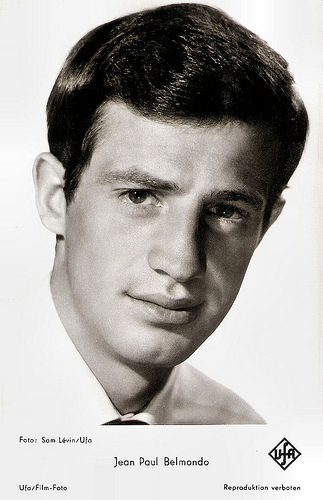
German postcard by Ufa/Film-Foto, no. 1133. Photo: Sam Lévin / Ufa.
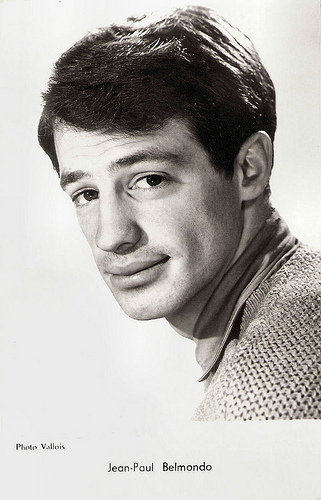
French postcard by Editions P.I., no. 1133. Photo: Vallois.
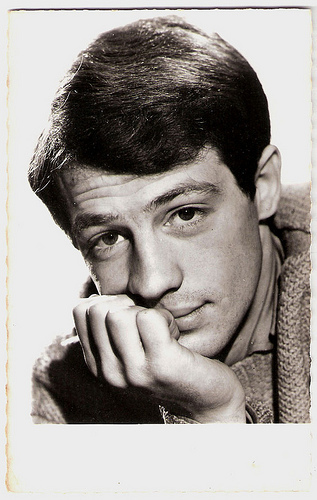
French postcard by Editions P.I., offered by Les Carbones Korès 'Carboplane', no. 1034. Photo: Studio Vallois.
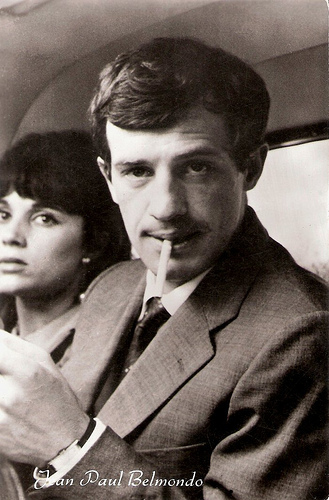
Dutch postcard by SYBA, no. 44/364.
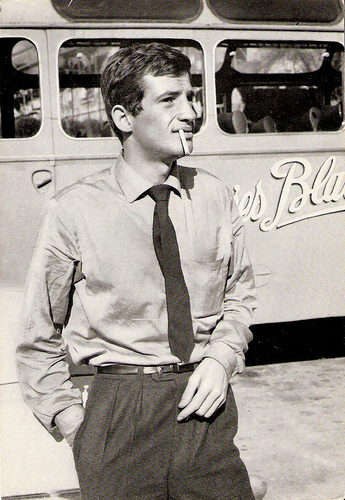
German postcard by WS-Druck, Wanne-Eickel, no. 559.
Mainstream
With L’homme de Rio/That Man from Rio (Philippe de Broca, 1964), Jean-Paul Belmondo switched to commercial, mainstream productions and became a big comedy and action star in France. During the production of their next hit comedy Les tribulations d'un Chinois en Chine/Chinese Adventures in China (Philippe de Broca, 1965), Belmondo fell in love with his co-star Ursula Andress. Following the example of Alain Delon he founded his own production company, Cerito Films, which produced around a dozen of his films over the next decade. Until the mid-1980s, his typical characters were either dashing adventurers or more cynical heroes in such films as Cent mille dollars au soleil/Greed in the Sun (Henri Verneuil, 1964) with Lino Ventura, Le Voleur/The Thief (Louis Malle, 1967), La Sirène du Mississipi/Mississippi Mermaid (Francois Truffaut, 1969) with Catherine Deneuve, Borsalino (Jacques Deray, 1970) opposite Alain Delon, and Stavisky... (Alain Resnais, 1974). Returning to his athletic roots, Belmondo became renowned for doing his own stunts as well as for his charming screen presence in such action films as the James Bond parody Le Magnifique/The Magnificent One (Philippe de Broca, 1973) with Jacqueline Bisset, L'Animal/The Beast (Claude Zidi, 1977) with Raquel Welch, and Le Professionnel/The Professional (Georges Lautner, 1981). Belmondo was one of France's biggest box-office stars of his time. He ceased to perform all the stunts himself after an accident during the filming of Hold-Up (Alexandre Arcady, 1985) with Kim Cattrall. He made a spectacular return to the theatre in 1987, appearing in Kean. Since then he has continued to perform on stage to great acclaim, whilst simultaneously pursuing his film career.
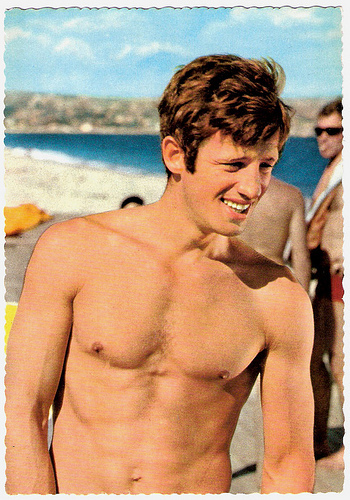
German postcard by Krüger, no. 902/345. Photo: Gérard Decaux.

Italian postcard. Photo: Dear Film. Publicity still for Les tribulations d'un Chinois en Chine/Chinese Adventures in China (Philippe de Broca, 1965).
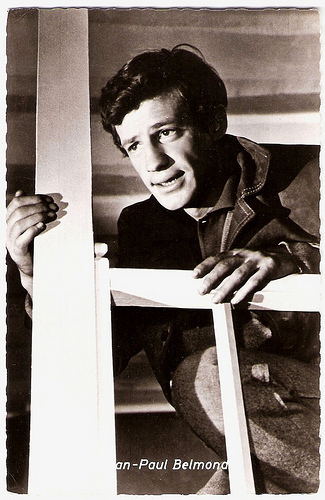
German postcard by Kolibri-Verlag G.m.b.H., Minden-Westf., no. 1334.
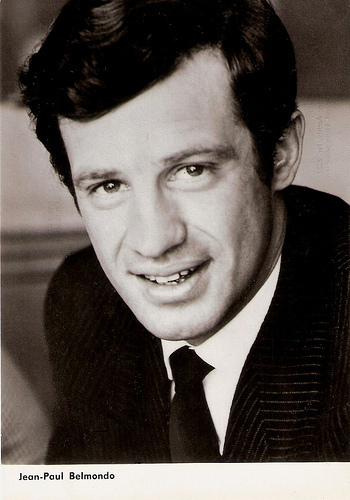
East-German postcard by VEB Progress Film-Vertrieb, Berlin, no. 2325.

Romanian postcard by Casa Filmului Acin, lei 2.
No César
Jean-Paul Belmondo now prefers mostly dramatic roles. In 1989 he was awarded the César for his performance in Itinéraire d'un enfant gâté/The Lion (Claude Lelouch, 1988). He refused to take the trophy because César, the sculptor who designed the award and gave it his name, had once expressed bad opinions about the work of his father. Another popular dramatic film was Les Misérables (Claude Lelouch, 1995). Jean-Paul Belmondo married twice. In 1953, he married dancer Élodie Constantin, with whom he had three children: Patricia (1958), Florence (1960) and Paul (1963). Paul became a Formula One driver; his eldest daughter Patricia was killed in a fire in 1994. In 1966, due to the well-publicized affair between Belmondo and actress Ursula Andress, Belmondo and his wife divorced. Later he had a long relationship with Italian actress Laura Antonelli. In 1989, he met Nathalie Tardivel who was 24 years old at the time. Belmondo married her in 2002. In 2001, he suffered a stroke and for years he was absent from stage and screen. In 2003, at the age of 70, his fourth child Stella was born. In 2008, Belmondo and Tardivel divorced. Since 2007 he has been 'Commandeur de la Légion d'honneur' (Commander of the Legion of Honour), France’s highest accolade. Recently he returned performing in the Theatre Marigny in Paris. His most recent film production is Un homme et son chien/A Man and His Dog (Francis Huster, 2009), a remake of the classic Umberto D (Vittorio De Sica, 1952). The film was not well-received. In 2011, the Cannes Film Festival paid tribute to him by giving him a special Palme d’Or to commemorate his exceptional body of work. But Jean-Paul Belmondo is not dead yet. In production now is his new collaboration with director Claude Lelouch, Les Bandits manchots (2013) .
Scene from Bébel's film debut Les Copains du dimanche (1956-1958). Source: ROBAGGIO10 (YouTube).
Scene from Borsalino (1970) with Jean-Paul Belmondo and Alain Delon. Source: myytsent (YouTube).
Trailer of Le Magnifique (1973). Source: vivadjango (YouTube).
Sources: Lucia Bozzola (AllMovie), James Travers (Films de France), Wikipedia, Films de France, and

Spanish postcard by Oscarcolor, Barcelona, no. 83, 1964. Photo: Sam Lévin.

French postcard by E.D.U.G., no. 160. Photo: Sam Lévin.

Italian postcard in the series Artisti di sempre by Rotalfoto, Milano, no. 355.

French postcard by E.D.U.G., no. 77. Photo: Lucienne Chevert.

French postcard by Editions P.I., Paris, no. 1065, presented by Corvisart, Epinal. Photo: Sam Lévin.
Bébel
Jean-Paul Belmondo was born in Neuilly-sur-Seine, a commune in the western suburbs of Paris, in 1933. He is the son of Paul Belmondo, a sculptor of Sicilian descent. Young Jean-Paul did not perform well at school, but developed a passion for boxing before he decided that his future lay in acting. After a number of attempts, he finally gained admittance to the Paris Conservatoire in 1952, although his tutors were not overly optimistic about his prospects. It was here that he acquired the nickname 'Bébel'. In the mid-1950s, he appeared in a few theatrical productions, often to great acclaim, before beginning a film career in 1956 with Les Copains du dimanche/The Sunday Friends (Henry Aisner, 1956-1958). The film was never played in public cinemas though and his episodes in À pied, à cheval et en voiture/On Foot, on Horse, and on Wheels (Maurice Delbez, 1957) were even cut before release, but soon bigger roles followed in the spoof thriller Sois Belle et Tais-Toi/Be Beautiful But Shut Up (Marc Allégret, 1957) - his first co-starring role with Alain Delon, the hit Les Tricheurs/The Cheaters (Marcel Carné, 1958) and À double tour/Web of Passion (Claude Chabrol, 1959) with Madeleine Robinson. It was in 1958 that the 25-year-old Belmondo attracted the attention of a former critic turned filmmaker Jean-Luc Godard. The latter was impressed by the actor’s spontaneity and cast him first in a quirky short, Charlotte et son Jules (1959).

French postcard by E.D.U.G., nr. 233. Photo: Sam Lévin.

French postcard by E.D.U.G., nr. 78. Photo: Lucienne Chevert.

Belgian collector's card, nr. 30.

Romanian postcard by Casa Filmului Acin. Photo: Sam Lévin.

French postcard by Editions P.I., no. 1136. Photo: Sam Lévin.
Breathless
Stardom came in 1959 when Jean-Paul Belmondo took the lead role of a sympathetic gangster in Godard’s landmark feature debut A Bout de souffle/Breathless (Jean-Luc Godard, 1960). At AllMovie , Lucia Bozzola writes: "Belmondo perfectly embodied the cool youthful rebellion guiding Godard's trailblazing cinematic style, rendering Belmondo the Gallic James Dean and heir apparent to Michel Simon and Jean Gabin." This film launched not just Belmondo’s film career but also the Nouvelle Vague , the New Wave of the French cinema. Belmondo would play a major part in the Nouvelle Vague during the early 1960s with roles in e.g. Une femme est une femme/A Woman Is a Woman (Jean-Luc Godard, 1961) and Pierrot le fou/Pierrot Goes Wild (Jean-Luc Godard, 1965). Besides these classics he also acted in a stream of other excellent films: Classe tous risques/The Big Risk (Claude Sautet, 1960) with Lino Ventura, Moderato cantabile/Seven Days... Seven Nights (Peter Brook, 1960), La Ciociara/Two Women (Vittorio De Sica, 1960) with Sophia Loren, and La Viaccia/The Lovemakers (Mauro Bolognini, 1961) with Claudia Cardinale. He played a priest in the dark World War II drama Léon Morin, prêtre/Leon Morin, Priest (Jean-Pierre Melville, 1961). Very popular was the swashbuckler Cartouche (Philippe de Broca, 1962) again with Cardinale. In Un singe en hiver/A Monkey in Winter (Henri Verneuil, 1962) he appeared with Jean Gabin. All that and the two films he made with Jean-Pierre Melville, Le Doulos/The Fingerman (Jean-Pierre Melville, 1962) and L’Aîné des Ferchaux/An Honorable Young Man (1963), which became modern classics of the film noir.

German postcard by Ufa/Film-Foto, no. 1133. Photo: Sam Lévin / Ufa.

French postcard by Editions P.I., no. 1133. Photo: Vallois.

French postcard by Editions P.I., offered by Les Carbones Korès 'Carboplane', no. 1034. Photo: Studio Vallois.

Dutch postcard by SYBA, no. 44/364.

German postcard by WS-Druck, Wanne-Eickel, no. 559.
Mainstream
With L’homme de Rio/That Man from Rio (Philippe de Broca, 1964), Jean-Paul Belmondo switched to commercial, mainstream productions and became a big comedy and action star in France. During the production of their next hit comedy Les tribulations d'un Chinois en Chine/Chinese Adventures in China (Philippe de Broca, 1965), Belmondo fell in love with his co-star Ursula Andress. Following the example of Alain Delon he founded his own production company, Cerito Films, which produced around a dozen of his films over the next decade. Until the mid-1980s, his typical characters were either dashing adventurers or more cynical heroes in such films as Cent mille dollars au soleil/Greed in the Sun (Henri Verneuil, 1964) with Lino Ventura, Le Voleur/The Thief (Louis Malle, 1967), La Sirène du Mississipi/Mississippi Mermaid (Francois Truffaut, 1969) with Catherine Deneuve, Borsalino (Jacques Deray, 1970) opposite Alain Delon, and Stavisky... (Alain Resnais, 1974). Returning to his athletic roots, Belmondo became renowned for doing his own stunts as well as for his charming screen presence in such action films as the James Bond parody Le Magnifique/The Magnificent One (Philippe de Broca, 1973) with Jacqueline Bisset, L'Animal/The Beast (Claude Zidi, 1977) with Raquel Welch, and Le Professionnel/The Professional (Georges Lautner, 1981). Belmondo was one of France's biggest box-office stars of his time. He ceased to perform all the stunts himself after an accident during the filming of Hold-Up (Alexandre Arcady, 1985) with Kim Cattrall. He made a spectacular return to the theatre in 1987, appearing in Kean. Since then he has continued to perform on stage to great acclaim, whilst simultaneously pursuing his film career.

German postcard by Krüger, no. 902/345. Photo: Gérard Decaux.

Italian postcard. Photo: Dear Film. Publicity still for Les tribulations d'un Chinois en Chine/Chinese Adventures in China (Philippe de Broca, 1965).

German postcard by Kolibri-Verlag G.m.b.H., Minden-Westf., no. 1334.

East-German postcard by VEB Progress Film-Vertrieb, Berlin, no. 2325.

Romanian postcard by Casa Filmului Acin, lei 2.
No César
Jean-Paul Belmondo now prefers mostly dramatic roles. In 1989 he was awarded the César for his performance in Itinéraire d'un enfant gâté/The Lion (Claude Lelouch, 1988). He refused to take the trophy because César, the sculptor who designed the award and gave it his name, had once expressed bad opinions about the work of his father. Another popular dramatic film was Les Misérables (Claude Lelouch, 1995). Jean-Paul Belmondo married twice. In 1953, he married dancer Élodie Constantin, with whom he had three children: Patricia (1958), Florence (1960) and Paul (1963). Paul became a Formula One driver; his eldest daughter Patricia was killed in a fire in 1994. In 1966, due to the well-publicized affair between Belmondo and actress Ursula Andress, Belmondo and his wife divorced. Later he had a long relationship with Italian actress Laura Antonelli. In 1989, he met Nathalie Tardivel who was 24 years old at the time. Belmondo married her in 2002. In 2001, he suffered a stroke and for years he was absent from stage and screen. In 2003, at the age of 70, his fourth child Stella was born. In 2008, Belmondo and Tardivel divorced. Since 2007 he has been 'Commandeur de la Légion d'honneur' (Commander of the Legion of Honour), France’s highest accolade. Recently he returned performing in the Theatre Marigny in Paris. His most recent film production is Un homme et son chien/A Man and His Dog (Francis Huster, 2009), a remake of the classic Umberto D (Vittorio De Sica, 1952). The film was not well-received. In 2011, the Cannes Film Festival paid tribute to him by giving him a special Palme d’Or to commemorate his exceptional body of work. But Jean-Paul Belmondo is not dead yet. In production now is his new collaboration with director Claude Lelouch, Les Bandits manchots (2013) .
Scene from Bébel's film debut Les Copains du dimanche (1956-1958). Source: ROBAGGIO10 (YouTube).
Scene from Borsalino (1970) with Jean-Paul Belmondo and Alain Delon. Source: myytsent (YouTube).
Trailer of Le Magnifique (1973). Source: vivadjango (YouTube).
Sources: Lucia Bozzola (AllMovie), James Travers (Films de France), Wikipedia, Films de France, and
Published on July 07, 2013 23:00
July 6, 2013
Lotte Koch
German-Belgian actress Lotte Koch (1913) appeared in anti-British propaganda films of the Ufa, but she also starred in Morituri (1948), the first German film about concentration camps and the Holocaust. At 100, she is now with Marta Eggerth the longest living Ufa star.
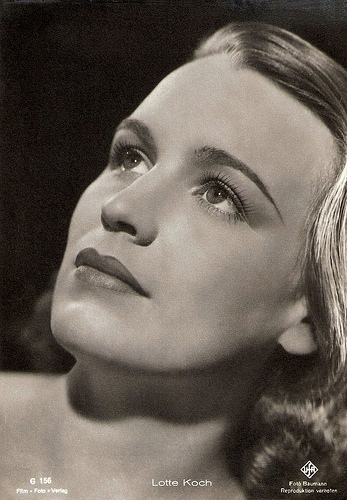
German postcard by Film-Foto-Verlag, no. G 156, 1941-1944. Photo: Baumann / Ufa.
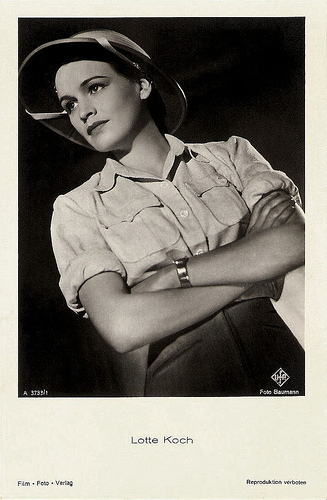
German postcard by Film-Foto-Verlag, no. A 3733/1, 1927-1928. Photo: Baumann / Ufa.
Die Pfeffermühle
Lotte Koch was born as Luise Charlotte Koch in Brussels, Belgium in 1913. After finishing school, she visited the Hochschule für Bühnenkunst (School of Performing Arts) in Dusseldorf, where she studied under Louise Dumont. She received her first theatre engagement in 1931 in Heidelberg. She was then engaged by the noted Schauspielhaus Zurich (1935-1937), where she played classical heroines as Luise in Kabale und Liebe (Intrigue and Love) by Friedrich Schiller and Helena in Jean Giraudoux's Der trojanische Krieg findet nicht statt (The Trojan war will not take place), both under the direction of Leopold Lindtberg. In Zürich, she also performed in Klaus and Erika Mann’s cabaret Die Pfeffermühle. In 1936 she made her film debut in the Johann Nepomuk Nestroy adaptation Lumpacivagabundus/Lumpaci the Vagabond (1936, Géza von Bolváry) with Paul Hörbiger and Heinz Rühmann. Then followed a pause in her film career of four years. In the meantime, she played on stage at the Volkstheater Wien (National Theatre Vienna) (1938-1939) and the Hamburger Kammerspiele (Hamburg Kammerspiele).
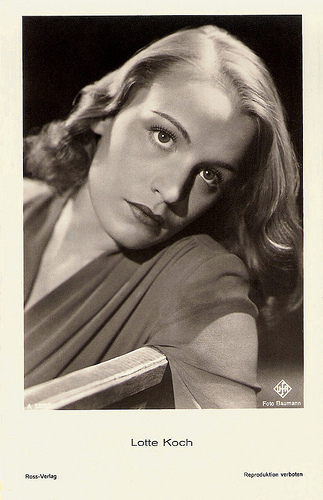
German postcard by Ross-Verlag, no. A 3325/1, 1941-1944. Photo: Baumann / Ufa.
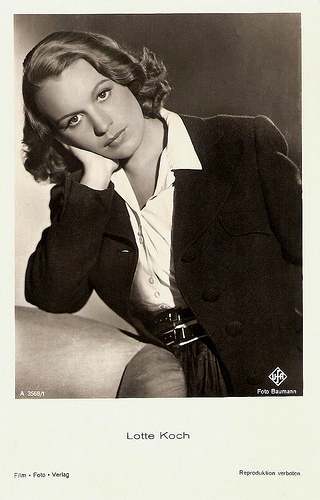
German postcard by Film-Foto-Verlag, no. A 3568/1, 1941-1944. Photo: Baumann / Ufa.
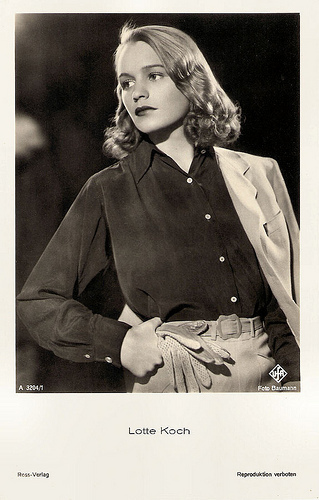
German postcard by Ross-Verlag, no. A 3204/1, 1941-1944. Photo: Baumann / Ufa.
MorituriDuring the Second World War, Lotte Koch regularly appeared in UFA productions, both in leading and supporting roles. She played in the historical melodrama, Das Herz der Königin/The Heart of the Queen (1940, Carl Froelich) starring Zarah Leander. The film made selective use of the tragic life story of Mary, Queen of Scots and her execution by Queen Elizabeth I for anti-British propaganda purposes. Her other films included the drama Friedemann Bach (1941, Traugott Müller, Gustaf Gründgens) with Gustaf Gründgens as the son of Sebastian Johann Bach, and the anti-British thriller Anschlag auf Baku/Attack on Baku (1942, Fritz Kirchhoff) starring Willy Fritsch and René Deltgen. In these films she was often cast as the assistant, a typical cliché role for women in the films of the Third Reich. After the war, Koch co-starred in the drama … und über uns der Himmel/City of Torment (1947, Josef von Báky). She played a young war widow opposite Hans Albers as a returning war veteran who has trouble finding work. A special film was Morituri (1948, Eugen York) in which she played the lead. The story was based in part on the life of producer Artur Brauner. It tells of the escape of Nazi concentration camp prisoners and how they manage to hide and evade recapture, though faced with constant danger and starvation. The film premiered at the Venice Film Festival 1948. In Germany, Morituri was a commercial disaster, with audiences hissing and booing. A theatre in Hamburg was vandalized, after which other theater owners, fearful of reprisal by Nazi sympathizers, refused to show the film. In her last film, the comedy Käpt'n Bay-Bay (1953, Helmut Käutner) she was again the partner of Hans Albers. In 1953 Lotte Koch finished her film career almost entirely. She worked for television and theatre. In 1971, she did her last screen role in the TV series Motiv Liebe/Motive Love (1971, Hermann Leitner). Lotte Koch was married to actor Ernst von Klipstein, who had been her co-star in Das Schwarze Schaf/The Black Sheep (1944, Miroslav Cikán) and three other films. Later, she married his brother, Dieter von Klipstein. She now lives in an elderly home in Unterhaching in the south of Germany. There, Lotte Koch had her 100th birthday on 9 March this year.
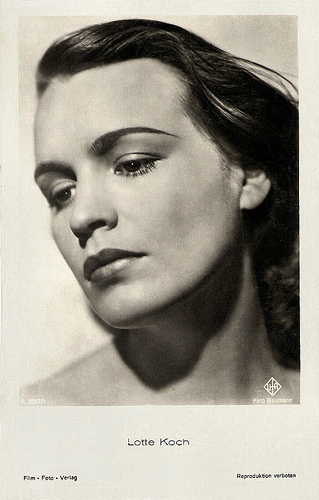
German postcard by Film-Foto-Verlag, no. A 3847/1, 1941-1944. Photo: Baumann / Ufa.
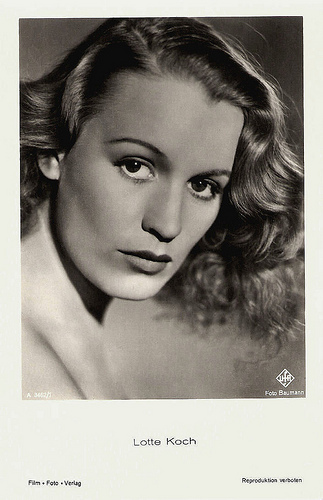
German postcard by Film-Foto-Verlag, no. A 3462/1, 1941-1944. Photo: Baumann / Ufa.
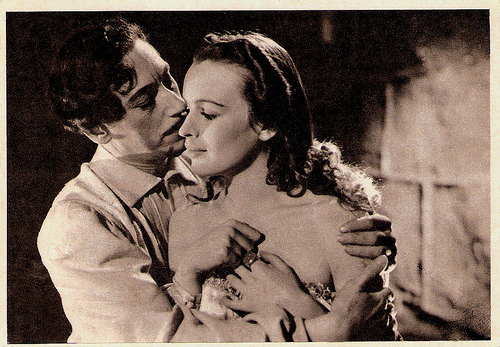
German postcard by Das Illustrierte Blatt . Photo: Ufa/Lindner. Publicity still for Das Herz der Königin/Mary Queen of Scots (1940, Carl Froelich) with Willy Birgel.
Sources: Stephanie D’heil (Steffi-Line), Thomas Staedeli (Cyranos), Hanns-Georg Rodek (Die Welt- German), AllMovie, Wikipedia (German) and

German postcard by Film-Foto-Verlag, no. G 156, 1941-1944. Photo: Baumann / Ufa.

German postcard by Film-Foto-Verlag, no. A 3733/1, 1927-1928. Photo: Baumann / Ufa.
Die Pfeffermühle
Lotte Koch was born as Luise Charlotte Koch in Brussels, Belgium in 1913. After finishing school, she visited the Hochschule für Bühnenkunst (School of Performing Arts) in Dusseldorf, where she studied under Louise Dumont. She received her first theatre engagement in 1931 in Heidelberg. She was then engaged by the noted Schauspielhaus Zurich (1935-1937), where she played classical heroines as Luise in Kabale und Liebe (Intrigue and Love) by Friedrich Schiller and Helena in Jean Giraudoux's Der trojanische Krieg findet nicht statt (The Trojan war will not take place), both under the direction of Leopold Lindtberg. In Zürich, she also performed in Klaus and Erika Mann’s cabaret Die Pfeffermühle. In 1936 she made her film debut in the Johann Nepomuk Nestroy adaptation Lumpacivagabundus/Lumpaci the Vagabond (1936, Géza von Bolváry) with Paul Hörbiger and Heinz Rühmann. Then followed a pause in her film career of four years. In the meantime, she played on stage at the Volkstheater Wien (National Theatre Vienna) (1938-1939) and the Hamburger Kammerspiele (Hamburg Kammerspiele).

German postcard by Ross-Verlag, no. A 3325/1, 1941-1944. Photo: Baumann / Ufa.

German postcard by Film-Foto-Verlag, no. A 3568/1, 1941-1944. Photo: Baumann / Ufa.

German postcard by Ross-Verlag, no. A 3204/1, 1941-1944. Photo: Baumann / Ufa.
MorituriDuring the Second World War, Lotte Koch regularly appeared in UFA productions, both in leading and supporting roles. She played in the historical melodrama, Das Herz der Königin/The Heart of the Queen (1940, Carl Froelich) starring Zarah Leander. The film made selective use of the tragic life story of Mary, Queen of Scots and her execution by Queen Elizabeth I for anti-British propaganda purposes. Her other films included the drama Friedemann Bach (1941, Traugott Müller, Gustaf Gründgens) with Gustaf Gründgens as the son of Sebastian Johann Bach, and the anti-British thriller Anschlag auf Baku/Attack on Baku (1942, Fritz Kirchhoff) starring Willy Fritsch and René Deltgen. In these films she was often cast as the assistant, a typical cliché role for women in the films of the Third Reich. After the war, Koch co-starred in the drama … und über uns der Himmel/City of Torment (1947, Josef von Báky). She played a young war widow opposite Hans Albers as a returning war veteran who has trouble finding work. A special film was Morituri (1948, Eugen York) in which she played the lead. The story was based in part on the life of producer Artur Brauner. It tells of the escape of Nazi concentration camp prisoners and how they manage to hide and evade recapture, though faced with constant danger and starvation. The film premiered at the Venice Film Festival 1948. In Germany, Morituri was a commercial disaster, with audiences hissing and booing. A theatre in Hamburg was vandalized, after which other theater owners, fearful of reprisal by Nazi sympathizers, refused to show the film. In her last film, the comedy Käpt'n Bay-Bay (1953, Helmut Käutner) she was again the partner of Hans Albers. In 1953 Lotte Koch finished her film career almost entirely. She worked for television and theatre. In 1971, she did her last screen role in the TV series Motiv Liebe/Motive Love (1971, Hermann Leitner). Lotte Koch was married to actor Ernst von Klipstein, who had been her co-star in Das Schwarze Schaf/The Black Sheep (1944, Miroslav Cikán) and three other films. Later, she married his brother, Dieter von Klipstein. She now lives in an elderly home in Unterhaching in the south of Germany. There, Lotte Koch had her 100th birthday on 9 March this year.

German postcard by Film-Foto-Verlag, no. A 3847/1, 1941-1944. Photo: Baumann / Ufa.

German postcard by Film-Foto-Verlag, no. A 3462/1, 1941-1944. Photo: Baumann / Ufa.

German postcard by Das Illustrierte Blatt . Photo: Ufa/Lindner. Publicity still for Das Herz der Königin/Mary Queen of Scots (1940, Carl Froelich) with Willy Birgel.
Sources: Stephanie D’heil (Steffi-Line), Thomas Staedeli (Cyranos), Hanns-Georg Rodek (Die Welt- German), AllMovie, Wikipedia (German) and
Published on July 06, 2013 23:00
July 5, 2013
Vittorio De Sica
Today it's the eighth and final day of
Il Cinema Ritrovato 2013
in Bologna, Italy. Our last festival post is about Vittorio De Sica (1901-1974). Bologna presents a retrospective about the Italian maestro: Tenderly Ironic: Vittorio De Sica, Actor and Director. Citing the festival newsletter: "A Maestro, a father, a beacon of Italian cinema. Vittorio De Sica is Italy's first modern superstar and a pivotal figure in our country's collective memory."
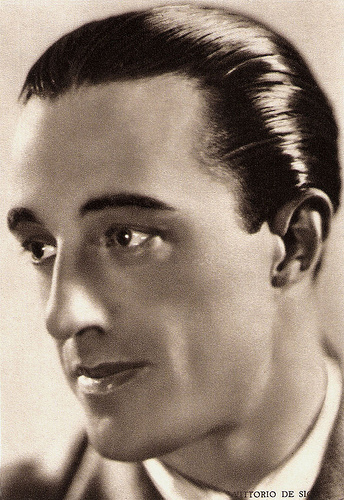
Italian postcard by Rizzoli S.C., Milano, 1936.
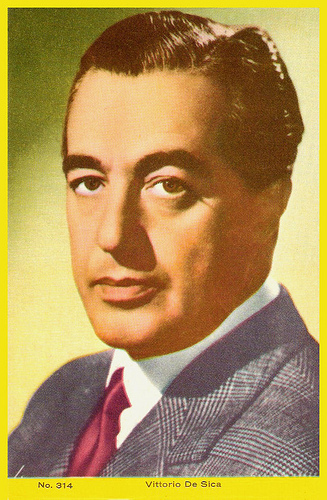
Mexican card, no. 314.
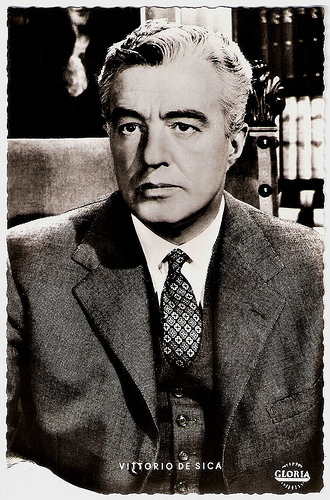
German postcard by Kunst und Bild, Berlin, no. V 377. Photo: Gloria Film. Publicity still for Racconti Romani/Roman Tales (Gianni Franciolini, 1955).
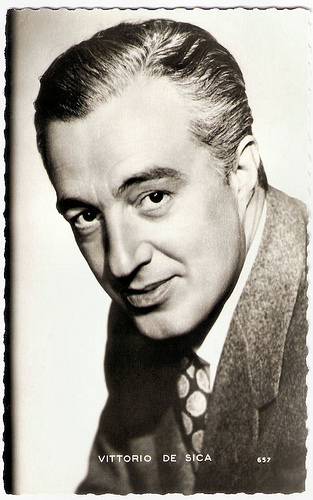
French postcard by Editions P.I., no. 37 G, presented by Les Carbones Korès Carboplane. Photo: Sam Lévin.
Successful Matinee Idol
Vittorio Domenico Stanislao Gaetano Sorano De Sica was born in Sora, Italy in 1901 (or 1902 - sources are divided). He grew up in Naples. His father, Umberto De Sica, a bank clerk with a penchant for show business, encouraged his good-looking son to pursue a stage career. Vittorio made his screen debut at 16 in the film Il processo Clémenceau/The Clemenceau Affair (Alfredo De Antoni, 1917) starring the legendary diva Francesca Bertini. He began his career as a theatre actor in the early 1920s and joined Tatiana Pavlova's theatre company in 1923. By the late 1920s he was a successful matinee idol of the Italian stage, and also appeared in such silent films as La bellezza del mondo/Beauty of the World (Mario Almirante, 1927) starring another silent film diva, Italia Almirante-Manzini. In 1933 De Sica founded his own theatre company with his wife, actress Giuditta Rissone, and Sergio Tofano. The company performed mostly light comedies. His good looks and breezy manner made him an overnight matinee idol of the Italian cinema with the release of his first sound picture, La Vecchia Signora/The Old Lady (Amleto Palermi, 1932). Light comedies as Gli uomini che mascalzoni!/What Scoundrels Men Are! (Mario Camerini, 1932) and Il signor Max/Mister Max (Mario Camerini, 1937) made him immensely popular with female audiences. During the Second World War De Sica turned to directing with Rose Scarlatte/Red Roses (Vittorio De Sica, Giuseppe Amato, 1940), and Maddelena, Zero in Condotta/Maddelena, Zero For Conduct (Vittorio De Sica, 1940). Both films were attempts to bring theatre pieces to the screen with suitable roles for himself. In the comedy of errors Teresa Venerdi (Vittorio De Sica, 1941) his girlfriend was played by a young Anna Magnani.
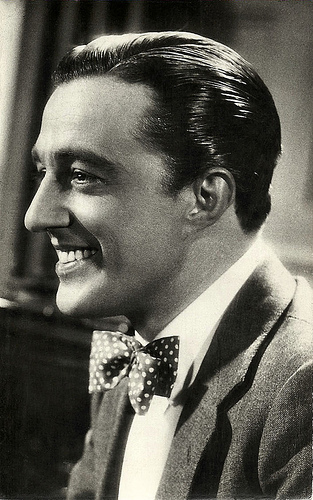
Spanish postcard by Editorial Brujuero, Barcelona, no. 481. Photo: Infonal, Archivo Bermeja.
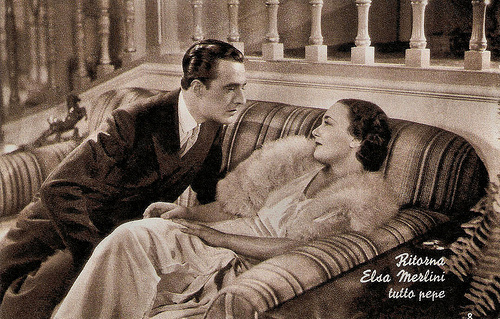
Italian postcard. The caption reads: Elsa Merlini returns, all pepper. Probably for the film Non ti conosco più/I Don't Know You Anymore (Nunzio Malasomma, Mario Bonnard, 1936). The pepper refers to the title of her previous film Paprika (Carl Boese, 1933).
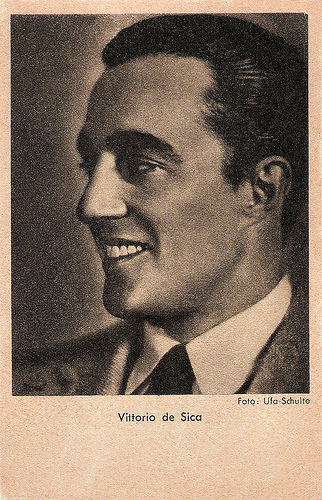
German postcard by Das Programm von Heute, Berlin. Photo: Ufa / Schulte.
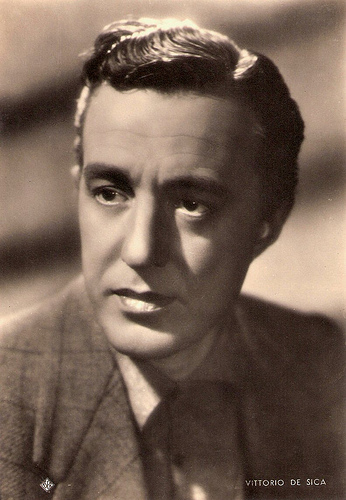
Italian postcard by Aser, Roma (Rome), no. 333. Photo: Vaselli.
Real Locations and Non-professional Actors
A turning point in Vittorio De Sica’s career was his meeting with the writer Cesare Zavattini. They worked together on De Sica’s fifth film, I bambini ci guardano/The Children Are Watching Us (Vittorio De Sica, 1943). In this film, the director began to use non-professional actors and socially conscious subject matter. He revealed hitherto unsuspected depths and an extraordinarily sensitive touch with actors, especially with children. It is a mature, perceptive, and deeply human work about the impact of adult folly on a child's innocent mind. Zavattini became as a scenarist his major collaborator for the next three decades. Together they created two of the most significant films of the Italian neorealism movement: Sciuscià/Shoeshine (Vittorio de Sica, 1946) and Ladri di biciclette/Bicycle Thieves (Vittorio de Sica, 1948). Sciuscià/Shoeshine is the story of how the lasting friendship of two homeless boys, who make their living shining shoes for the American G.I.'s, is betrayed by their contact with adults. At the end of the film one boy inadvertently causes the other's death. In Ladri di biciclette/Bicycle Thieves, workman Ricci's desperate search for his bicycle is an odyssey that enables us to witness a varied collection of characters and situations among the poor and working class of Rome. At Sony Pictures Classics an anonymous critic writes: “With no money available to produce his films, De Sica initiated the use of real locations and non-professional actors. Using available light and documentary effects, he explored the relationship between working and lower-class characters in an indifferent, and often hostile social and political environment. The result was gritty and searing storytelling that not only bared the truth about the harsh conditions inflicted on Italy's poor, but also represented a radical break from filmmaking conventions.” Both films are heartbreaking studies of poverty in postwar Italy and both won special Oscars before the foreign film category was officially established. De Sica's next collaboration with Zavattini was the satirical fantasy, Miracolo a Milano/Miracle in Milan (Vittorio de Sica, 1951), which wavered between optimism and despair in its allegorical treatment of the plight of the poor in an industrial society. Their next film, Umberto D. (Vittorio de Sica, 1952), was a relentlessly bleak study of the problems of old age and loneliness, but it was a box-office disaster. Continually wooed by Hollywood, De Sica finally acquiesced to make Stazioni Termini (Vittorio de Sica, 1952), clumsily renamed Indiscretion of an American Wife in the US It was produced by David O. Selznick and filmed in Rome with in the leading roles Selznick's wife, Jennifer Jones and Montgomery Clift. Unfortunately, neorealist representation formed only an insignificant background to this typically American star vehicle.
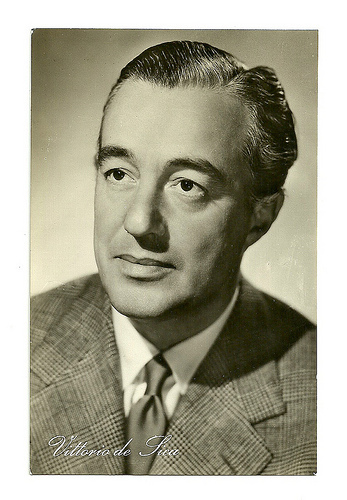
East-German postcard by Progress-Filmvertrieb.
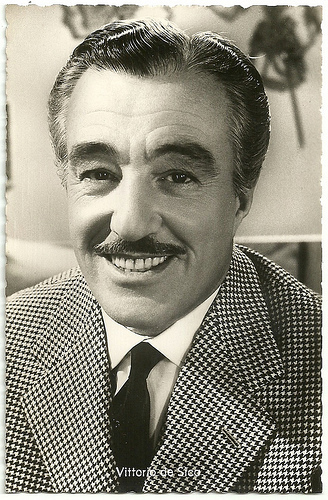
German postcard by Kolibri-Verlag, Minden. Photo: Bavaria Filmkunst-Eichberg-Marszalos. Publicity still for the Franco-Italian-German film Casino de Paris (André Hunebelle, 1957).
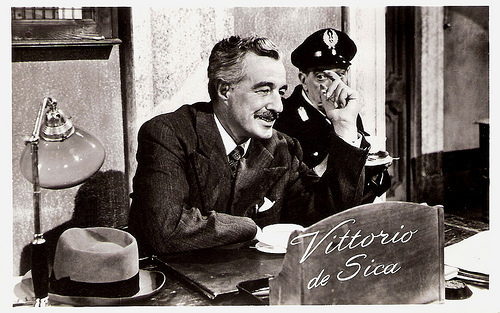
Dutch postcard by Takken, no. 1679.
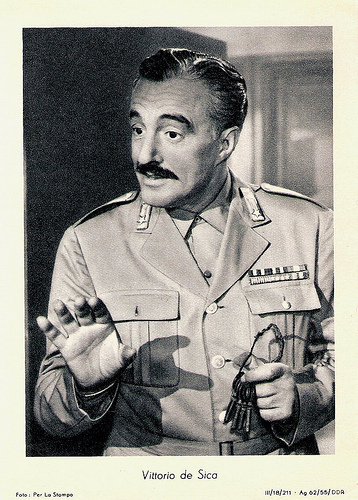
East-German postcard, no. III/18/211, 1955. Photo: Per la Stampa. De Sica wears the uniform of the marshall from the film Pane, amore e fantasia (and its sequels).
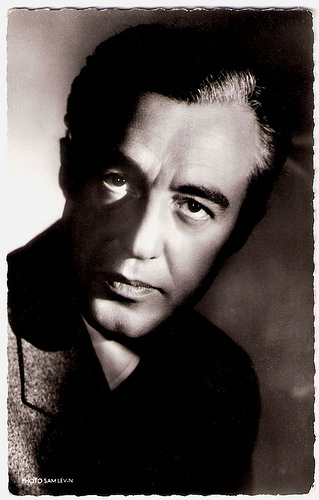
French postcard by Editions du Globe, Paris, no. 610. Photo: Sam Lévin.
Bread Love and Dreams
During his lifetime, Vittorio De Sica acted in over one hundred films in Italy and abroad, in order to finance his own directorial projects. He turned almost exclusively to acting in the late 1950s, enjoying great popularity in the role of the rural police officer Carotenuto in Pane, amore e fantasia/Bread, Love and Dreams (Luigi Comencini, 1954) opposite Gina Lollobrigida. He returned in a subsequent comedy series of the same name co-starring Lollobrigida or Sophia Loren. He was at his best playing breezy comic heroes, men of great self-assurance or confidence - such as in Rossellini's General Della Rovere (Roberto Rossellini, 1959). On TV he became well known in the British Series The Four Just Men (1959) produced by Sapphire Films. With the notable exception of Il Tetto/The Roof (Vittorio de Sica, 1956) and La Ciociara/Two Women (Vittorio de Sica, 1960), for which Sophia Loren won an Oscar for Best Actress, his subsequent output as a director was for a long while markedly less inspired and significant. He had two box-office hits with Matrimonio All'Italiana/Marriage Italian Style (Vittorio de Sica, 1964) starring Loren and Marcello Mastroianni, and with Ieri, oggi, domain/Yesterday, Today and Tomorrow (Vittorio de Sica, 1964) which won him another Oscar. However, critics and audiences alike had concluded that the aging director had lost his touch, but, just before he died he made a dramatic comeback with Il giardino dei Finzi Contini/The Garden of the Finzi-Continis (Vittorio de Sica, 1970). The film was based on a Bassani novel about the incarceration of Italian Jews during the war. According to Joel Kanoff at Film Reference it shows “a strong Viscontian influence in its lavish setting and thematics (the film deals with the dissolution of the bourgeois family).” It won him yet another Oscar. The director's next film was Una breve vacanza/A Brief Vacation (Vittorio de Sica, 1973), about a working-class Italian woman's first taste of freedom in a society dominated by males. His last film, Il Viaggio/The Voyage (Vittorio de Sica, 1974), was based on a novella by Luigi Pirandello. That year, he passed away following the removal of a cyst from his lungs. He had been married to Giuditta Rissone (1937-1968) and to Spanish actress María Mercader (1968-1974) with whom he had two sons, composer-director Manuel De Sica and actor-singer Christian De Sica. De Sica lived with Mercader from 1942 on, but couldn't marry her until 1968 after acquiring French citizenship, which allowed him to finally divorce Rissone. In 1974, Vittorio De Sica died near Paris in Neuilly-sur-Seine, at the age of 72. Active to the end, he appeared as himself in Scola's melancholic comedy-drama C'eravamo tanto amati/We All Loved Each Other So Much (Ettore Scola, 1974), which was released after his death.
A young Vittorio De Sica sings Parlami d'amore Mariu' in Gli uomini che mascalzoni!/What Scoundrels Men Are! (1932). Source: Matteoeoeo (YouTube).
Scene from Miracolo a Milano/Miracle in Milan (1953). Source: Arcilsota (YouTube).
Sophia Loren and Vittorio De Sica dance the mambo in Pane, amore e.../Bread, Love and ... (1955). Source: Il Romanziere (YouTube).
Sources: Joel Kanoff (Film Reference), Dan Harper (Senses of Cinema),

Italian postcard by Rizzoli S.C., Milano, 1936.

Mexican card, no. 314.

German postcard by Kunst und Bild, Berlin, no. V 377. Photo: Gloria Film. Publicity still for Racconti Romani/Roman Tales (Gianni Franciolini, 1955).

French postcard by Editions P.I., no. 37 G, presented by Les Carbones Korès Carboplane. Photo: Sam Lévin.
Successful Matinee Idol
Vittorio Domenico Stanislao Gaetano Sorano De Sica was born in Sora, Italy in 1901 (or 1902 - sources are divided). He grew up in Naples. His father, Umberto De Sica, a bank clerk with a penchant for show business, encouraged his good-looking son to pursue a stage career. Vittorio made his screen debut at 16 in the film Il processo Clémenceau/The Clemenceau Affair (Alfredo De Antoni, 1917) starring the legendary diva Francesca Bertini. He began his career as a theatre actor in the early 1920s and joined Tatiana Pavlova's theatre company in 1923. By the late 1920s he was a successful matinee idol of the Italian stage, and also appeared in such silent films as La bellezza del mondo/Beauty of the World (Mario Almirante, 1927) starring another silent film diva, Italia Almirante-Manzini. In 1933 De Sica founded his own theatre company with his wife, actress Giuditta Rissone, and Sergio Tofano. The company performed mostly light comedies. His good looks and breezy manner made him an overnight matinee idol of the Italian cinema with the release of his first sound picture, La Vecchia Signora/The Old Lady (Amleto Palermi, 1932). Light comedies as Gli uomini che mascalzoni!/What Scoundrels Men Are! (Mario Camerini, 1932) and Il signor Max/Mister Max (Mario Camerini, 1937) made him immensely popular with female audiences. During the Second World War De Sica turned to directing with Rose Scarlatte/Red Roses (Vittorio De Sica, Giuseppe Amato, 1940), and Maddelena, Zero in Condotta/Maddelena, Zero For Conduct (Vittorio De Sica, 1940). Both films were attempts to bring theatre pieces to the screen with suitable roles for himself. In the comedy of errors Teresa Venerdi (Vittorio De Sica, 1941) his girlfriend was played by a young Anna Magnani.

Spanish postcard by Editorial Brujuero, Barcelona, no. 481. Photo: Infonal, Archivo Bermeja.

Italian postcard. The caption reads: Elsa Merlini returns, all pepper. Probably for the film Non ti conosco più/I Don't Know You Anymore (Nunzio Malasomma, Mario Bonnard, 1936). The pepper refers to the title of her previous film Paprika (Carl Boese, 1933).

German postcard by Das Programm von Heute, Berlin. Photo: Ufa / Schulte.

Italian postcard by Aser, Roma (Rome), no. 333. Photo: Vaselli.
Real Locations and Non-professional Actors
A turning point in Vittorio De Sica’s career was his meeting with the writer Cesare Zavattini. They worked together on De Sica’s fifth film, I bambini ci guardano/The Children Are Watching Us (Vittorio De Sica, 1943). In this film, the director began to use non-professional actors and socially conscious subject matter. He revealed hitherto unsuspected depths and an extraordinarily sensitive touch with actors, especially with children. It is a mature, perceptive, and deeply human work about the impact of adult folly on a child's innocent mind. Zavattini became as a scenarist his major collaborator for the next three decades. Together they created two of the most significant films of the Italian neorealism movement: Sciuscià/Shoeshine (Vittorio de Sica, 1946) and Ladri di biciclette/Bicycle Thieves (Vittorio de Sica, 1948). Sciuscià/Shoeshine is the story of how the lasting friendship of two homeless boys, who make their living shining shoes for the American G.I.'s, is betrayed by their contact with adults. At the end of the film one boy inadvertently causes the other's death. In Ladri di biciclette/Bicycle Thieves, workman Ricci's desperate search for his bicycle is an odyssey that enables us to witness a varied collection of characters and situations among the poor and working class of Rome. At Sony Pictures Classics an anonymous critic writes: “With no money available to produce his films, De Sica initiated the use of real locations and non-professional actors. Using available light and documentary effects, he explored the relationship between working and lower-class characters in an indifferent, and often hostile social and political environment. The result was gritty and searing storytelling that not only bared the truth about the harsh conditions inflicted on Italy's poor, but also represented a radical break from filmmaking conventions.” Both films are heartbreaking studies of poverty in postwar Italy and both won special Oscars before the foreign film category was officially established. De Sica's next collaboration with Zavattini was the satirical fantasy, Miracolo a Milano/Miracle in Milan (Vittorio de Sica, 1951), which wavered between optimism and despair in its allegorical treatment of the plight of the poor in an industrial society. Their next film, Umberto D. (Vittorio de Sica, 1952), was a relentlessly bleak study of the problems of old age and loneliness, but it was a box-office disaster. Continually wooed by Hollywood, De Sica finally acquiesced to make Stazioni Termini (Vittorio de Sica, 1952), clumsily renamed Indiscretion of an American Wife in the US It was produced by David O. Selznick and filmed in Rome with in the leading roles Selznick's wife, Jennifer Jones and Montgomery Clift. Unfortunately, neorealist representation formed only an insignificant background to this typically American star vehicle.

East-German postcard by Progress-Filmvertrieb.

German postcard by Kolibri-Verlag, Minden. Photo: Bavaria Filmkunst-Eichberg-Marszalos. Publicity still for the Franco-Italian-German film Casino de Paris (André Hunebelle, 1957).

Dutch postcard by Takken, no. 1679.

East-German postcard, no. III/18/211, 1955. Photo: Per la Stampa. De Sica wears the uniform of the marshall from the film Pane, amore e fantasia (and its sequels).

French postcard by Editions du Globe, Paris, no. 610. Photo: Sam Lévin.
Bread Love and Dreams
During his lifetime, Vittorio De Sica acted in over one hundred films in Italy and abroad, in order to finance his own directorial projects. He turned almost exclusively to acting in the late 1950s, enjoying great popularity in the role of the rural police officer Carotenuto in Pane, amore e fantasia/Bread, Love and Dreams (Luigi Comencini, 1954) opposite Gina Lollobrigida. He returned in a subsequent comedy series of the same name co-starring Lollobrigida or Sophia Loren. He was at his best playing breezy comic heroes, men of great self-assurance or confidence - such as in Rossellini's General Della Rovere (Roberto Rossellini, 1959). On TV he became well known in the British Series The Four Just Men (1959) produced by Sapphire Films. With the notable exception of Il Tetto/The Roof (Vittorio de Sica, 1956) and La Ciociara/Two Women (Vittorio de Sica, 1960), for which Sophia Loren won an Oscar for Best Actress, his subsequent output as a director was for a long while markedly less inspired and significant. He had two box-office hits with Matrimonio All'Italiana/Marriage Italian Style (Vittorio de Sica, 1964) starring Loren and Marcello Mastroianni, and with Ieri, oggi, domain/Yesterday, Today and Tomorrow (Vittorio de Sica, 1964) which won him another Oscar. However, critics and audiences alike had concluded that the aging director had lost his touch, but, just before he died he made a dramatic comeback with Il giardino dei Finzi Contini/The Garden of the Finzi-Continis (Vittorio de Sica, 1970). The film was based on a Bassani novel about the incarceration of Italian Jews during the war. According to Joel Kanoff at Film Reference it shows “a strong Viscontian influence in its lavish setting and thematics (the film deals with the dissolution of the bourgeois family).” It won him yet another Oscar. The director's next film was Una breve vacanza/A Brief Vacation (Vittorio de Sica, 1973), about a working-class Italian woman's first taste of freedom in a society dominated by males. His last film, Il Viaggio/The Voyage (Vittorio de Sica, 1974), was based on a novella by Luigi Pirandello. That year, he passed away following the removal of a cyst from his lungs. He had been married to Giuditta Rissone (1937-1968) and to Spanish actress María Mercader (1968-1974) with whom he had two sons, composer-director Manuel De Sica and actor-singer Christian De Sica. De Sica lived with Mercader from 1942 on, but couldn't marry her until 1968 after acquiring French citizenship, which allowed him to finally divorce Rissone. In 1974, Vittorio De Sica died near Paris in Neuilly-sur-Seine, at the age of 72. Active to the end, he appeared as himself in Scola's melancholic comedy-drama C'eravamo tanto amati/We All Loved Each Other So Much (Ettore Scola, 1974), which was released after his death.
A young Vittorio De Sica sings Parlami d'amore Mariu' in Gli uomini che mascalzoni!/What Scoundrels Men Are! (1932). Source: Matteoeoeo (YouTube).
Scene from Miracolo a Milano/Miracle in Milan (1953). Source: Arcilsota (YouTube).
Sophia Loren and Vittorio De Sica dance the mambo in Pane, amore e.../Bread, Love and ... (1955). Source: Il Romanziere (YouTube).
Sources: Joel Kanoff (Film Reference), Dan Harper (Senses of Cinema),
Published on July 05, 2013 23:00
July 4, 2013
Elvire Popesco
This year, one of the major sections of
Il Cinema Ritrovato
(29 June - 6 July 2013) is War is near: 1938-1939. The festival organisation did not make the most obvious choices for the section, but selected "films which captivate fear and frail hopes, random shadows, inconclusive dialogues, everything that the greatest films around that period, such as Renoir's La Règle du jeu, did so miraculously". One of these films is Paradis perdu/Paradise Lost (1939), directed by Abel Gance and starring Elvire Popesco (1894-1993), a French actress of Romanian origin. In the twenties she went to Paris, where she conquered the stages with her comic talent and heavy accent. In the thirties she became a popular film star, who worked with such great directors as Julien Duvivier, Sacha Guitry, Marc Allégret, and of course Abel Gance.
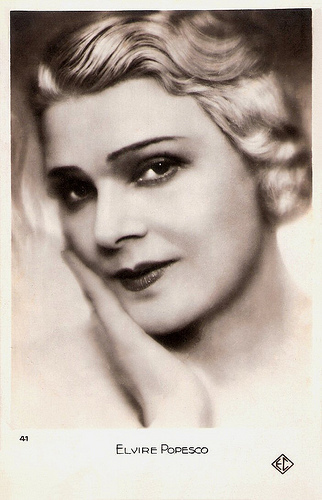
French postcard by EC, no. 41.
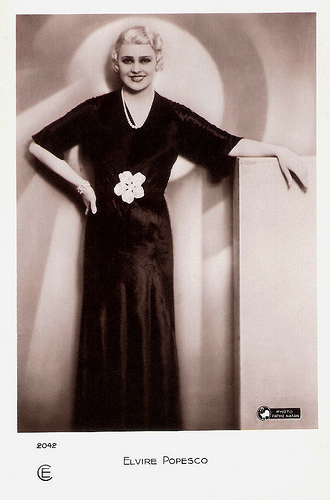
French postcard by CE (Cinemagazine-Selection), Paris, no. 2042. Photo: Pathé Natan.
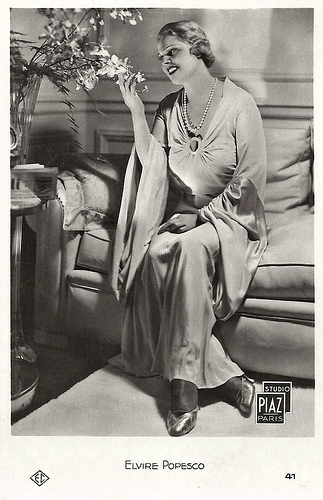
French postcard by EC, no. 41. Photo: Studio Piaz, Paris.
Artistic Director
Elvire Popesco was born Elvira Popescu in Bucharest, Romania in 1894. She started to perform at the Teatrul Naţional (Bucharest national theatre) after a training at the Conservatorul de Artă Dramatică din Bucureşti (Bucharest Conservatory for Drama). She played a small part in the Romanian silent film Independenta Romaniei/The War for Independence (Aristide Demetriade, 1912), inspired by the war between Romania and the Ottoman Empire. It was the first Romanian feature film to last for nearly two hours (from which are about 20 minutes lost now). Seven years later Elvira became the artistic director of the Excelsior Theatre (1919) and subsequently of the Teatrul Mic (1921). Then she played in the film Tigancusa de la iatac/The girl of the garret (Alfred Halm, 1923). French playwright Louis Verneuil convinced her to go to Paris. Around 1924 she rose to stardom at the Parisian stages because of her comic talent and her heavy accent. She was Verneuil's favourite actress in the later 1920s and early 1930s. He first cast her in Ma cousine de Varsovie (1923). In 1931 she would also play in the film version of this play, directed by the Italian director Carmine Gallone. Actually, from the start of sound cinema in France, Popesco had a growing prolific career there, culminating in nine film parts in 1938-1939. She worked with a wide range of directors, a.o. four times with Pierre Colombier (including Tricoche et Cacolet/Tricoche and Cacolet, 1938), but also with Julien Duvivier (L'Homme du jour/The Man of the Hour, 1936), Abel Gance (Paradis perdu/Paradise Lost, 1939), Sacha Guitry (Ils étaient neuf célibataires/Nine Bachelors, 1939), and Marc Allégret (Parade en sept nuits/Parade in 7 Nights, 1940). Her co-stars in those years were men like Maurice Chevalier, Louis Jouvet, Erich von Stroheim, Fernandel, and Henri Garat.
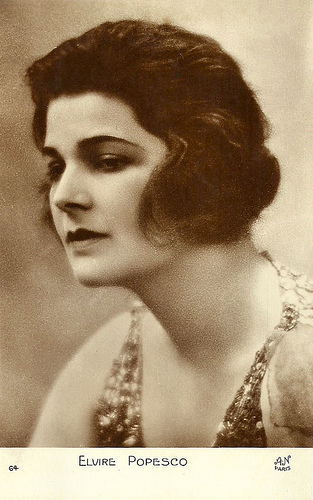
French postcard by A.N., Paris, no. 64.
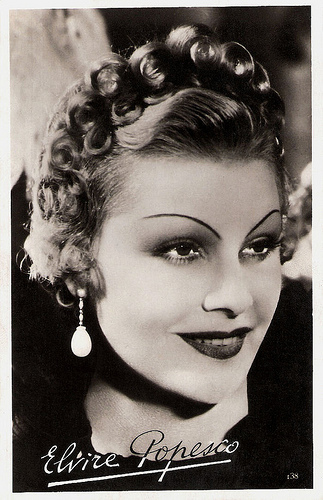
French postcard by Editions et Publications Cinématographiques, no. 138.
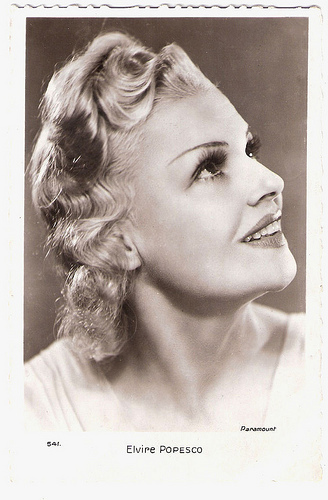
French postcard by Ed. Chantal, Paris, no. 541. Photo: Paramount.
A Big Stage Come-back
In the first war years Elvire Popesco continued to play in films like Mademoiselle Swing (Richard Pottier, 1941) with Jean Murat and Irène de Trebert. Presumably this affected her career because only in 1948 she could make a big stage come-back with Tovaritch by Jacques Deval, which was retaken with Popesco in 1960. After that Popesco had again an active stage career, playing for instance in three pieces by André Roussin: Nina (1949), La voyante (1963-1964), and La Mamma (1957-1958, 1974); the latter was purposefully written for her by Roussin. She also performed in La machine infernale by Jean Cocteau (1953). From 1953 to 1965 she was director of the Théàtre de Paris and subsequently of the Théàtre de Marigny (1965-1978). In 1959 Popesco returned to the cinema and played her last film parts in Plein soleil/Purple Noon (René Clement, 1960) starring Alain Delon, and as Napoleon's mother in Austerlitz/The Battle of Austerlitz (Abel Gance, 1960). After she had married the count Maximilien Sebastien Foy (her third husband), Popesco kept a well-frequented salon in Mézy-sur-Seine (Yvelines). From 1930 to 1985 she lived there in a modernist-style villa, owned before by fashion designer Paul Poiret, and remodelled in 1932 by architect Paul Boyer. Together with Anna de Noailles, Marthe Bibesco and Elena Vacarescu, Popesco seems to have been Henri Matisse's inspiration for his La blouse roumaine (1940). In 1987 Popesco was awarded a Molière d’honneur for her entire career, and in 1989 president François Mitterrand made her a Commandeur de la Légion d'honneur. Elvire Popesco died in 1993 in Paris at the age of 99. She lies buried at the Cimetière du Père-Lachaise in Paris. She was married to comedian Aurel Athanasescu with whom she had a daughter, Tatiana; to politician Ion Manolescu-Stronga (Minister of Industry and Commerce), and to count Maximilien Sebastien Foy.
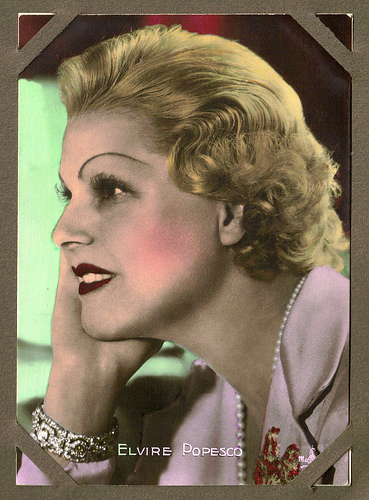
French card by Massilia. Collection: Amit Benyovits.
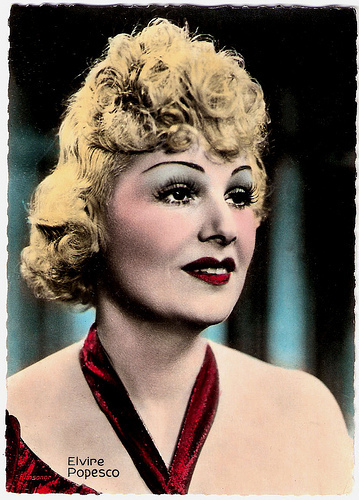
French postcard. Photo: Filmsonor.
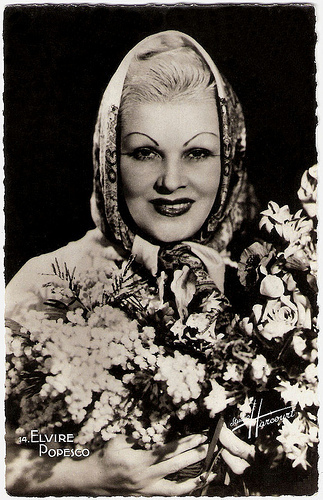
French postcard by S.E.R.P., no. 14. Photo: Studio Harcourt.
Sources: Caroline Hanotte (CinéArtistes), Wikipedia, and

French postcard by EC, no. 41.

French postcard by CE (Cinemagazine-Selection), Paris, no. 2042. Photo: Pathé Natan.

French postcard by EC, no. 41. Photo: Studio Piaz, Paris.
Artistic Director
Elvire Popesco was born Elvira Popescu in Bucharest, Romania in 1894. She started to perform at the Teatrul Naţional (Bucharest national theatre) after a training at the Conservatorul de Artă Dramatică din Bucureşti (Bucharest Conservatory for Drama). She played a small part in the Romanian silent film Independenta Romaniei/The War for Independence (Aristide Demetriade, 1912), inspired by the war between Romania and the Ottoman Empire. It was the first Romanian feature film to last for nearly two hours (from which are about 20 minutes lost now). Seven years later Elvira became the artistic director of the Excelsior Theatre (1919) and subsequently of the Teatrul Mic (1921). Then she played in the film Tigancusa de la iatac/The girl of the garret (Alfred Halm, 1923). French playwright Louis Verneuil convinced her to go to Paris. Around 1924 she rose to stardom at the Parisian stages because of her comic talent and her heavy accent. She was Verneuil's favourite actress in the later 1920s and early 1930s. He first cast her in Ma cousine de Varsovie (1923). In 1931 she would also play in the film version of this play, directed by the Italian director Carmine Gallone. Actually, from the start of sound cinema in France, Popesco had a growing prolific career there, culminating in nine film parts in 1938-1939. She worked with a wide range of directors, a.o. four times with Pierre Colombier (including Tricoche et Cacolet/Tricoche and Cacolet, 1938), but also with Julien Duvivier (L'Homme du jour/The Man of the Hour, 1936), Abel Gance (Paradis perdu/Paradise Lost, 1939), Sacha Guitry (Ils étaient neuf célibataires/Nine Bachelors, 1939), and Marc Allégret (Parade en sept nuits/Parade in 7 Nights, 1940). Her co-stars in those years were men like Maurice Chevalier, Louis Jouvet, Erich von Stroheim, Fernandel, and Henri Garat.

French postcard by A.N., Paris, no. 64.

French postcard by Editions et Publications Cinématographiques, no. 138.

French postcard by Ed. Chantal, Paris, no. 541. Photo: Paramount.
A Big Stage Come-back
In the first war years Elvire Popesco continued to play in films like Mademoiselle Swing (Richard Pottier, 1941) with Jean Murat and Irène de Trebert. Presumably this affected her career because only in 1948 she could make a big stage come-back with Tovaritch by Jacques Deval, which was retaken with Popesco in 1960. After that Popesco had again an active stage career, playing for instance in three pieces by André Roussin: Nina (1949), La voyante (1963-1964), and La Mamma (1957-1958, 1974); the latter was purposefully written for her by Roussin. She also performed in La machine infernale by Jean Cocteau (1953). From 1953 to 1965 she was director of the Théàtre de Paris and subsequently of the Théàtre de Marigny (1965-1978). In 1959 Popesco returned to the cinema and played her last film parts in Plein soleil/Purple Noon (René Clement, 1960) starring Alain Delon, and as Napoleon's mother in Austerlitz/The Battle of Austerlitz (Abel Gance, 1960). After she had married the count Maximilien Sebastien Foy (her third husband), Popesco kept a well-frequented salon in Mézy-sur-Seine (Yvelines). From 1930 to 1985 she lived there in a modernist-style villa, owned before by fashion designer Paul Poiret, and remodelled in 1932 by architect Paul Boyer. Together with Anna de Noailles, Marthe Bibesco and Elena Vacarescu, Popesco seems to have been Henri Matisse's inspiration for his La blouse roumaine (1940). In 1987 Popesco was awarded a Molière d’honneur for her entire career, and in 1989 president François Mitterrand made her a Commandeur de la Légion d'honneur. Elvire Popesco died in 1993 in Paris at the age of 99. She lies buried at the Cimetière du Père-Lachaise in Paris. She was married to comedian Aurel Athanasescu with whom she had a daughter, Tatiana; to politician Ion Manolescu-Stronga (Minister of Industry and Commerce), and to count Maximilien Sebastien Foy.

French card by Massilia. Collection: Amit Benyovits.

French postcard. Photo: Filmsonor.

French postcard by S.E.R.P., no. 14. Photo: Studio Harcourt.
Sources: Caroline Hanotte (CinéArtistes), Wikipedia, and
Published on July 04, 2013 23:00
July 3, 2013
Silvana Mangano
In the past
Il Cinema Ritrovato
(29 June - 6 July 2013) had many CinemaScope screenings at the Arlecchino theatre, which we really enjoyed. This year we can look at the magic of the European Scope (the festival organisation defined it so to take into account all of the variations the widescreen systems adopted in our continent). The section Bigger than Life: a journey through European CinemaScope will include Mario Monicelli's La grande guerra/The Great War (1959), starring Alberto Sordi, Vittorio Gassman, and in the female lead, beautiful Silvana Mangano (1930-1989). The Italian film star will forever be remembered as the sexy rice picker in Riso amaro/Bitter Rice (1949), and as Tadzio's elegant mother in Morte a Venezia/Death in Venice (1971). She worked four times with maestro Luchino Visconti, and three times with another major director, Pier Paolo Pasolini.
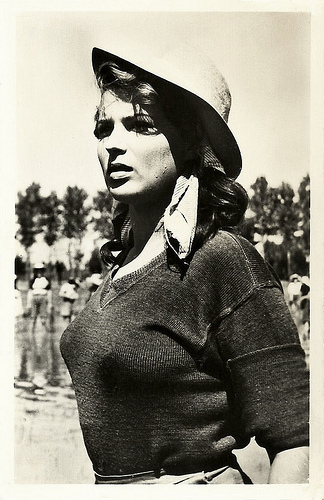
Dutch postcard by Filmverhuurkantoor Centrafilm, Dordrecht.
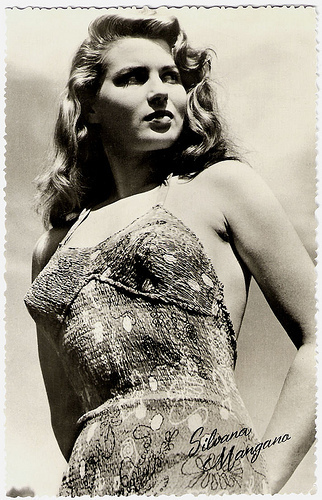
Dutch postcard by DRC, no. F 196. Photo: Lux Film.
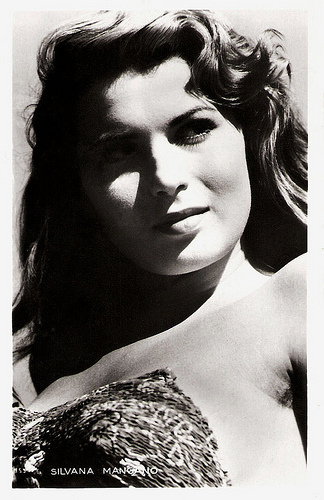
French postcard by Editions P.I., no. 159.
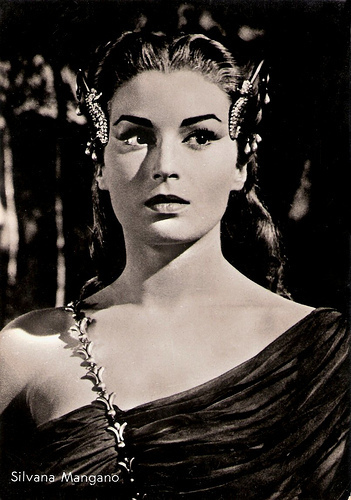
Italian postcard by Bromostampa, Milano (Milan), no. 37. Photo: still from Ulisse/Ulysses (Mario Camerini, 1954), produced by Silvana's husband, Dino De Laurentiis.
Shocking Hotpants
Silvana Mangano was born in Rome in 1930 to an Italian father, a Sicilian train conductor, and an English mother. Her brother is sound technician Roy Mangano and her sisters are one-time actresses Patrizia Mangano and Natascia Mangano. Silvana grew up in poverty caused by the Second World War. Trained for seven years as a dancer, she was supporting herself as a model. At 16, she won the Miss Rome beauty contest in 1946 and got a small role in the opera adaptation L'Elisir d'amore/Elixir of Love (Mario Costa, 1948) with Tito Gobbi. She was also nominated for the Miss Italia contest in 1947, which Lucia Bosé won. Mangano started to play small roles in films like Il delitto di Giovanni Episcopo/Flesh Will Surrender (Alberto Lattuada, 1947), Gli uomini sono nemici/Crossroads of Passion (1948, Ettore Giannini) with French diva Viviane Romance, and Black Magic (Gregory Ratoff, 1949) starring Orson Welles. She had her breakthrough with the neo-realistic crime story Riso amaro/Bitter Rice (Giuseppe De Santis, 1949), situated in the rice fields along the Po river in Northern Italy. Managano played the voluptuous rice picker Silvana, who falls for the criminal Walter (Vittorio Gassman) and his presumed wealth. The thousands of female rice workers, up to their ankles in the water, breaking their backs in the burning sun to earn a few bucks, make an impressive decor. To the standards of 1949s Roman Catholic Italy Mangano's performance in hotpants was shocking. This earned Riso Amaro a lot of publicity, and earned Mangano a contract with the Lux company.
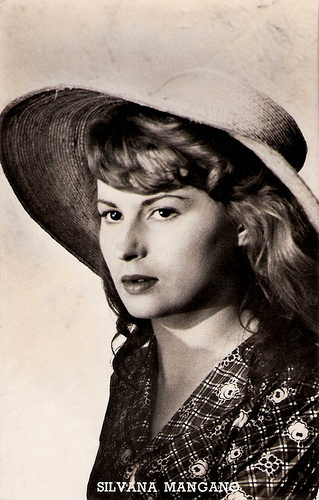
French postcard, no. 850. Photo: Lux Film.
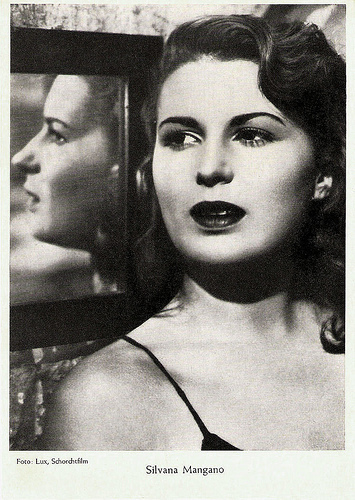
German collectors card. Photo: Lux / Schorchtfilm.
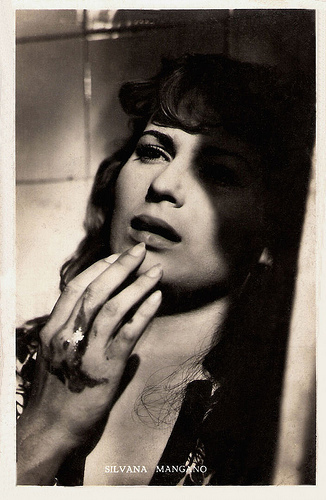
Belgian postcard by Nieuwe Merksemsche Chocolaterie, Merksem. Photo: Lux Film Rome. Publicity still for Riso Amaro/Bitter Rice (1949).
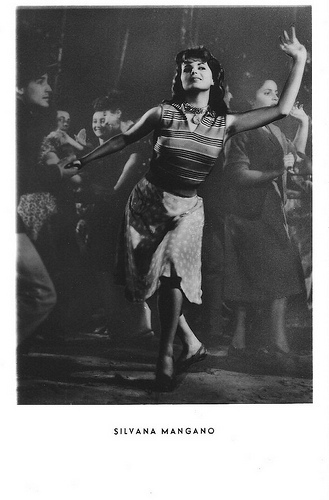
German postcard by Netter's Star Verlag, Berlin. Publicity still for Riso Amaro/Bitter Rice (1949).
Pig-fancying Enchantress
Though Silvana Mangano never scaled the heights of her competitors Sophia Loren and Gina Lollobrigida, she was a popular European film star in the 1950s and 1960s. Lux produced her subsequent films such as Anna (Alberto Lattuada, 1951) with Raf Vallone, and Ulisse/Ulysses (Mario Camerini, 1954), an adaptation of Homer's second epic featuring Kirk Douglas. Mangano played both Ulysses' faithful wife Penelope and the pig-fancying enchantress Circe. In 1949, she had married producer Dino De Laurentiis who controlled her career and launched her as the leading lady of international co-productions such as Mambo (Robert Rossen, 1954) with Michael Rennie, This Angry Age/Le barrage sur le Pacifique (René Clément, 1958) with Anthony Perkins, and 5 Branded Woman/Jovanka e le altre (Martin Ritt, 1960) with Jeanne Moreau.
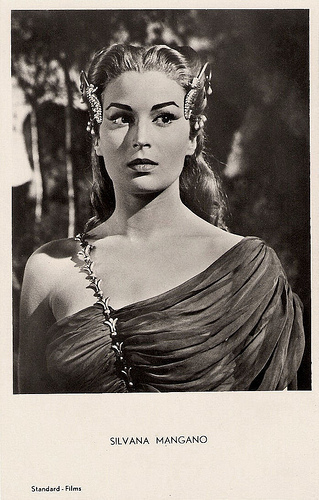
Dutch postcard, nr. 34. Photo: Standard-Films. Still from Ulisse/Ulysses (1954) in which Mangano played Circe/Penelope.
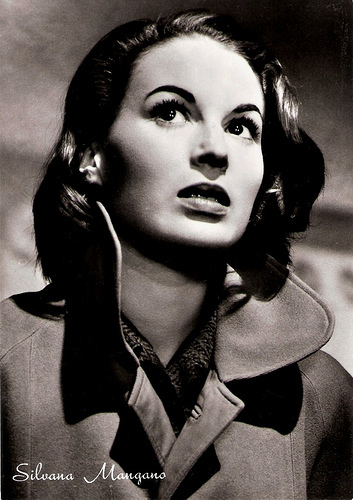
Italian postcard by Rotalfoto, Milano (Milan), no. 230.
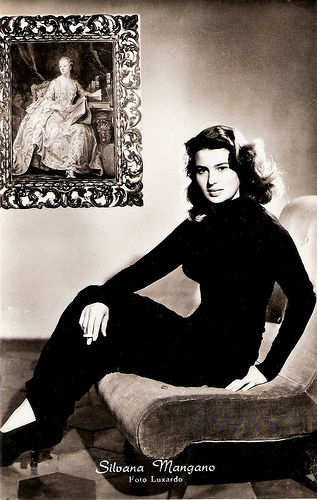
Dutch postcard, no. 857. Photo: Luxardo.
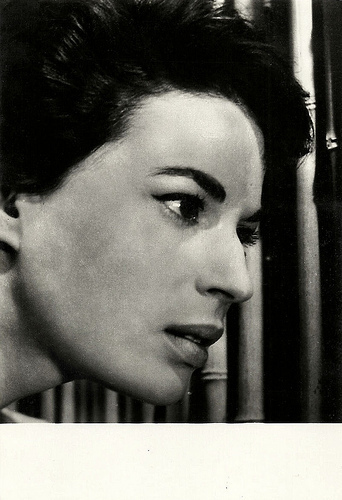
Italian postcard by Bromostampa, Milano in the series 'Hobby'.
Visconti and Pasolini
In 1967, Silvana Mangano starred in the anthology film Le streghe/The Witches (1967) with five episodes directed by Mauro Bolognini, Vittorio De Sica, Pier Paolo Pasolini, Franco Rossi and Luchino Visconti. Visconti shot the quite cynical and biographical episode La strega bruciata viva/The Witch Burned Alive, and he later cast her again as Tadzio's (Björn Andrésen) aristocratic mother in Morte a Venezia/Death in Venice (Luchino Visconti, 1971), modeled on Visconti's own mother. She also played the cunning Cosima von Bülow in Ludwig (Luchino Visconti, 1972), and the hysterical marchesa Brumonti in Gruppo di famiglia in un interno/Conversation Piece (Luchino Visconti, 1974) opposite Burt Lancaster. Mangano also performed in three films by Pasolini: as Jocaste in Edipo re/Oedipus Rex (Pier Paolo Pasolini, 1967), an updated version of the Greek tragedy by Sophocles; as Lucia, the mother in Teorema/Theorem (Pier Paolo Pasolini, 1968) with Terence Stamp, and as the Holy Virgin - a small, uncredited role - in Il Decameron/The Decameron (Pier Paolo Pasolini, 1971).
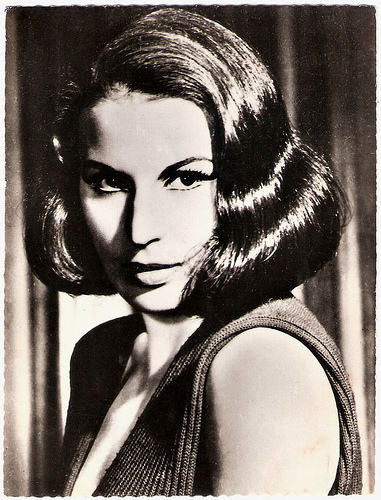
Vintage postcard, no. 2067.
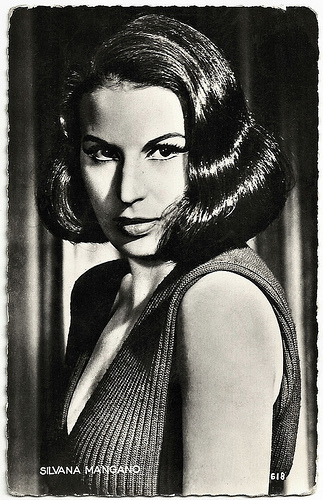
French postcard by Editions P.I., Paris, offered by Les Carbones Korès, no. 618.
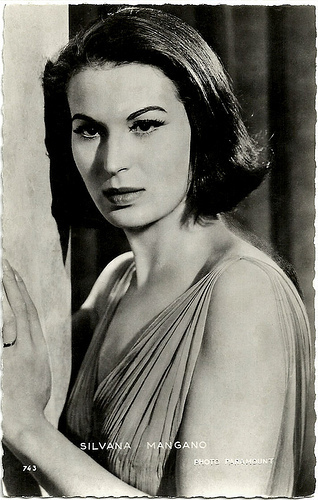
French postcard. Editions P.I., Paris, no. 743.
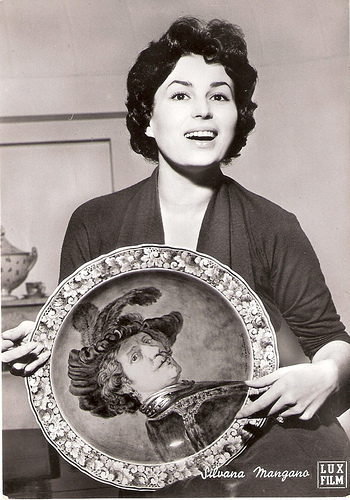
Italian postcard by Bromofoto, Milano. Photo: Lux Film. Mangano holds up a kitschy copy of a man's portrait (ca. 1635) by Dutch painter Rembrandt van Rijn, now at the Mauritshuis at the Hague.
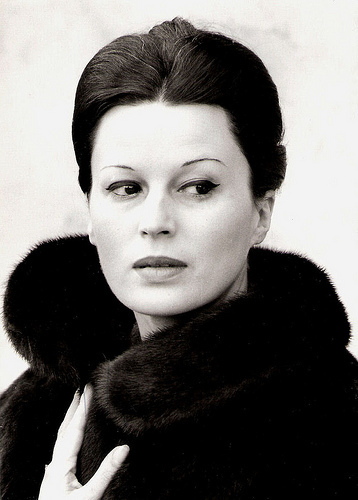
Italian postcard by Ferrania. Photo: Dino De Laurentiis Cinematografica.
Tapestries
In the 1980s, Silvana Mangano's life took a bad turn. In 1981 her son, Federico De Laurentiis, was killed in an Alaskan air crash. In 1983 she separated from Dino De Laurentiis , though they did not divorce. She did not perform in films anymore, except for Dune (David Lynch, 1984) and Oci ciornie/Dark Eyes (Nikita Mikhalkov, 1987), in which she played Romano's (Marcello Mastroianni) wife. She dedicated her time to making tapestries, alternating her domicile between Madrid and Paris. Silvana Mangano, who had always been a strong smoker, died of lung cancer in 1989, in a hospital in Madrid. She was only 59. Silvana Mangano had four children with Dino De Laurentiis: Veronica, Raffaella, Francesca, and the deceased Federico. Veronica's daughter Giada De Laurentiis is host of Everyday Italian on the Food Network. Raffaella coproduced with her father on Mangano's penultimate film, Dune.
Scene from Riso amaro/Bitter Rice (1949). Source: boct2007 (YouTube).
Scene from Anna (1951). Silvana sings El negro zumbon. Source: jack11anbar (YouTube).
Trailer of Morte a Venezia/Death in Venice (1971). Source: enneme (YouTube).
Sources: Hal Erickson (AllMovie), Wikipedia and

Dutch postcard by Filmverhuurkantoor Centrafilm, Dordrecht.

Dutch postcard by DRC, no. F 196. Photo: Lux Film.

French postcard by Editions P.I., no. 159.

Italian postcard by Bromostampa, Milano (Milan), no. 37. Photo: still from Ulisse/Ulysses (Mario Camerini, 1954), produced by Silvana's husband, Dino De Laurentiis.
Shocking Hotpants
Silvana Mangano was born in Rome in 1930 to an Italian father, a Sicilian train conductor, and an English mother. Her brother is sound technician Roy Mangano and her sisters are one-time actresses Patrizia Mangano and Natascia Mangano. Silvana grew up in poverty caused by the Second World War. Trained for seven years as a dancer, she was supporting herself as a model. At 16, she won the Miss Rome beauty contest in 1946 and got a small role in the opera adaptation L'Elisir d'amore/Elixir of Love (Mario Costa, 1948) with Tito Gobbi. She was also nominated for the Miss Italia contest in 1947, which Lucia Bosé won. Mangano started to play small roles in films like Il delitto di Giovanni Episcopo/Flesh Will Surrender (Alberto Lattuada, 1947), Gli uomini sono nemici/Crossroads of Passion (1948, Ettore Giannini) with French diva Viviane Romance, and Black Magic (Gregory Ratoff, 1949) starring Orson Welles. She had her breakthrough with the neo-realistic crime story Riso amaro/Bitter Rice (Giuseppe De Santis, 1949), situated in the rice fields along the Po river in Northern Italy. Managano played the voluptuous rice picker Silvana, who falls for the criminal Walter (Vittorio Gassman) and his presumed wealth. The thousands of female rice workers, up to their ankles in the water, breaking their backs in the burning sun to earn a few bucks, make an impressive decor. To the standards of 1949s Roman Catholic Italy Mangano's performance in hotpants was shocking. This earned Riso Amaro a lot of publicity, and earned Mangano a contract with the Lux company.

French postcard, no. 850. Photo: Lux Film.

German collectors card. Photo: Lux / Schorchtfilm.

Belgian postcard by Nieuwe Merksemsche Chocolaterie, Merksem. Photo: Lux Film Rome. Publicity still for Riso Amaro/Bitter Rice (1949).

German postcard by Netter's Star Verlag, Berlin. Publicity still for Riso Amaro/Bitter Rice (1949).
Pig-fancying Enchantress
Though Silvana Mangano never scaled the heights of her competitors Sophia Loren and Gina Lollobrigida, she was a popular European film star in the 1950s and 1960s. Lux produced her subsequent films such as Anna (Alberto Lattuada, 1951) with Raf Vallone, and Ulisse/Ulysses (Mario Camerini, 1954), an adaptation of Homer's second epic featuring Kirk Douglas. Mangano played both Ulysses' faithful wife Penelope and the pig-fancying enchantress Circe. In 1949, she had married producer Dino De Laurentiis who controlled her career and launched her as the leading lady of international co-productions such as Mambo (Robert Rossen, 1954) with Michael Rennie, This Angry Age/Le barrage sur le Pacifique (René Clément, 1958) with Anthony Perkins, and 5 Branded Woman/Jovanka e le altre (Martin Ritt, 1960) with Jeanne Moreau.

Dutch postcard, nr. 34. Photo: Standard-Films. Still from Ulisse/Ulysses (1954) in which Mangano played Circe/Penelope.

Italian postcard by Rotalfoto, Milano (Milan), no. 230.

Dutch postcard, no. 857. Photo: Luxardo.

Italian postcard by Bromostampa, Milano in the series 'Hobby'.
Visconti and Pasolini
In 1967, Silvana Mangano starred in the anthology film Le streghe/The Witches (1967) with five episodes directed by Mauro Bolognini, Vittorio De Sica, Pier Paolo Pasolini, Franco Rossi and Luchino Visconti. Visconti shot the quite cynical and biographical episode La strega bruciata viva/The Witch Burned Alive, and he later cast her again as Tadzio's (Björn Andrésen) aristocratic mother in Morte a Venezia/Death in Venice (Luchino Visconti, 1971), modeled on Visconti's own mother. She also played the cunning Cosima von Bülow in Ludwig (Luchino Visconti, 1972), and the hysterical marchesa Brumonti in Gruppo di famiglia in un interno/Conversation Piece (Luchino Visconti, 1974) opposite Burt Lancaster. Mangano also performed in three films by Pasolini: as Jocaste in Edipo re/Oedipus Rex (Pier Paolo Pasolini, 1967), an updated version of the Greek tragedy by Sophocles; as Lucia, the mother in Teorema/Theorem (Pier Paolo Pasolini, 1968) with Terence Stamp, and as the Holy Virgin - a small, uncredited role - in Il Decameron/The Decameron (Pier Paolo Pasolini, 1971).

Vintage postcard, no. 2067.

French postcard by Editions P.I., Paris, offered by Les Carbones Korès, no. 618.

French postcard. Editions P.I., Paris, no. 743.

Italian postcard by Bromofoto, Milano. Photo: Lux Film. Mangano holds up a kitschy copy of a man's portrait (ca. 1635) by Dutch painter Rembrandt van Rijn, now at the Mauritshuis at the Hague.

Italian postcard by Ferrania. Photo: Dino De Laurentiis Cinematografica.
Tapestries
In the 1980s, Silvana Mangano's life took a bad turn. In 1981 her son, Federico De Laurentiis, was killed in an Alaskan air crash. In 1983 she separated from Dino De Laurentiis , though they did not divorce. She did not perform in films anymore, except for Dune (David Lynch, 1984) and Oci ciornie/Dark Eyes (Nikita Mikhalkov, 1987), in which she played Romano's (Marcello Mastroianni) wife. She dedicated her time to making tapestries, alternating her domicile between Madrid and Paris. Silvana Mangano, who had always been a strong smoker, died of lung cancer in 1989, in a hospital in Madrid. She was only 59. Silvana Mangano had four children with Dino De Laurentiis: Veronica, Raffaella, Francesca, and the deceased Federico. Veronica's daughter Giada De Laurentiis is host of Everyday Italian on the Food Network. Raffaella coproduced with her father on Mangano's penultimate film, Dune.
Scene from Riso amaro/Bitter Rice (1949). Source: boct2007 (YouTube).
Scene from Anna (1951). Silvana sings El negro zumbon. Source: jack11anbar (YouTube).
Trailer of Morte a Venezia/Death in Venice (1971). Source: enneme (YouTube).
Sources: Hal Erickson (AllMovie), Wikipedia and
Published on July 03, 2013 23:00
July 2, 2013
John Stuart
We're still in Italy and enjoy
Il Cinema Ritrovato
(29 June - 6 July 2013). In the section Silent Hitch, Alfred Hitchcock's nine surviving silent films are screened. The collection starts with his debut, the sensational The Pleasure Garden (1925), a newly born film which was believed to be lost for many years. Male star of The Pleasure Garden is the Scottish actor John Stuart (1898-1979), a very popular leading man in British silent films in the 1920s.
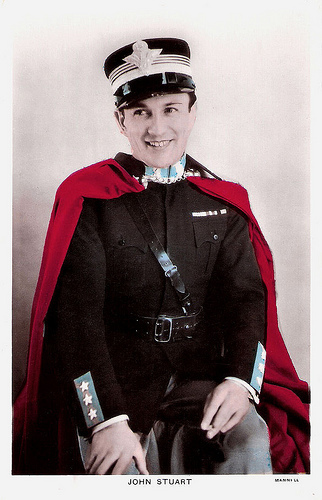
British postcard in the Colourgraph Series, London, no. C. 237. Photo: Mannell.
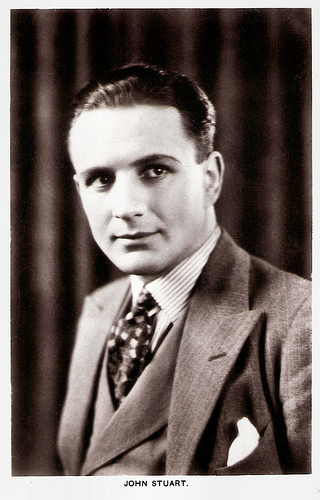
British postcard in the Picturegoer Series, London, no. 54c.
Instant Star
John Stuart was born John Alfred Louden Croall in Edinburgh, Scotland in 1898. He began his stage and screen career directly after World War I service in The Black Watch. He made his film debut in the drama The Lights of Home (Fred Paul, 1920). Other silent films were the drama If Four Walls Told (Fred Paul, 1922) starring Lillian Hall-Davis, the comedy The School for Scandal (Bertram Phillips, 1923) with Queenie Thomas, and the comedy We Women (W.P. Kellino, 1925). Stuart was a very popular leading man in British silent films, though it's hard to gauge that popularity since many of his best films of the 1920s, such as A Sporting Double (Arthur Rooke, 1923), Constant Hot Water (George A. Cooper, 1924) and The Tower of London (Maurice Elvey, 1926) with Isobel Elsom, are either inaccessible or non-existent. He appeared in a silent film directed by Alfred Hitchcock. The Pleasure Garden (1925) was Hitchcock’s directorial debut. Based on a novel by Oliver Sandys, the film is about two chorus girls at the Pleasure Garden Theatre in London and their troubled relationships. Glamorous American star Virginia Valli played the lead. The film was shot in Italy and Germany in 1925 and shown to the British press in March 1926. But it was not officially released in the UK until 1927, after Hitchcock's film The Lodger: A Story of the London Fog became a massive hit in February 1927. Stuart worked several times with director Maurice Elvey. Very popular was their World War I drama Mademoiselle from Armentieres (Maurice Elvey, 1926), featuring Estelle Brody. The film opened in London in September 1926 and was still playing in cinemas around the country until well into 1927. It was reportedly the most profitable British film of 1926 and made an instant star of Brody. The two stars were reunited in the drama Hindle Wakes (Maurice Elvey, 1927), which skilful use of location is considered to give the film a documentary realism feel very unusual in British films of the period. Brody and Stuart co-starred again in Mademoiselle Parley Voo (Maurice Elvey, 1928), a sequel to Mademoiselle from Armentieres, and equally successful. By the way, both films refer to the popular First World War song Mademoiselle from Armentières.

Lillian Hall-Davis German postcard by Ross Verlag, Berlin, no. 1479/2, 1927-1928. Photo: Ufa.
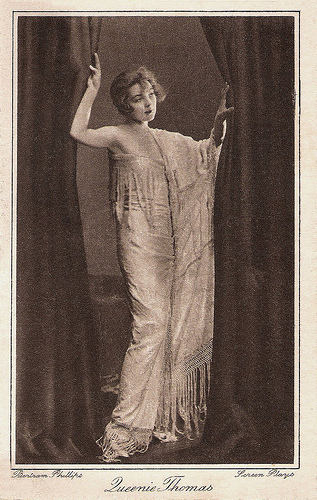
Queenie Thomas. British postcard in the series Screen Plays. Photo: Bertram Phillips.
Number Seventeen
John Stuart’s first sound film, Kitty (Victor Saville, 1929) was another successful production. Kitty was initially planned and filmed as a silent, but on its original completion director Saville decided to reshoot the latter part with sound. As no suitable facilities were yet available in Britain, Saville, Estelle Brody and Stuart travelled to New York to shoot the new sequences at RKO Studios. The film was released in the form of a silent which switched to sound after the half-way point. Stuart’s next film, Atlantic (1929) was one of the first British films made with the soundtrack optically recorded on the film (sound-on-film). Atlantic was directed and produced by Ewald André Dupont. Three versions were made, an English and a German language version, Atlantik, which were shot simultaneously, and later a French version was made. In England, Atlantic was released in both sound and silent prints. The film was originally made as Titanic but after lawsuits it was renamed Atlantic. The White Star Line, which owned the RMS Titanic, was still in operation at the time. The final scene of the film was filmed as a shot of the liner sinking but it was cut at the last minute as it was feared it would upset Titanic survivors. Then Stuart worked for a second time with Alfred Hitchcock, although indirectly. Elstree Calling (1930) is a lavish musical film revue directed by Andre Charlot, Jack Hulbert, Paul Murray, and Hitchcock at Elstree Studios. It was Britain's answer to the Hollywood revues, such as Paramount on Parade (Dorothy Arzner et al, 1930) and The Hollywood Review of 1929 (Charles Reisner, 1929). Stuart was not appearing in the segments directed by Hitchcock. They really worked together again on Number Seventeen (Alfred Hitchcock, 1932), in which Stuart played the lead. The film is about a group of criminals who committed a jewel robbery and put their money in an old house over a railway leading to the English Channel, the film's title being derived from the house's street number. An outsider stumbles onto this plot and intervenes with the help of a neighbour, a police officer's daughter. On its initial release, audiences reacted to Number Seventeen with confusion and disappointment. Stuart then played Sir Henry Baskerville in the mystery The Hound of the Baskervilles (Gareth Gundrey, 1932), based on the novel by Arthur Conan Doyle and scripted by Edgar Wallace. He was the co-star of Brigitte Helm in The Mistress of Atlantis (Georg Wilhelm Pabst, 1932), the English language version of the German-French adventure and fantasy film L'Atlantide/Die Herrin von Atlantis (Georg Wilhelm Pabst, 1932) based on the novel L'Atlantide by Pierre Benoît.
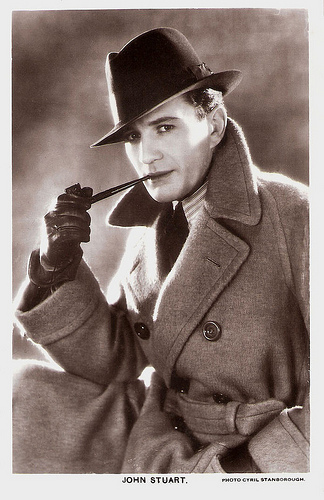
British postcard in the Picturegoer Series, London, no. 54e.
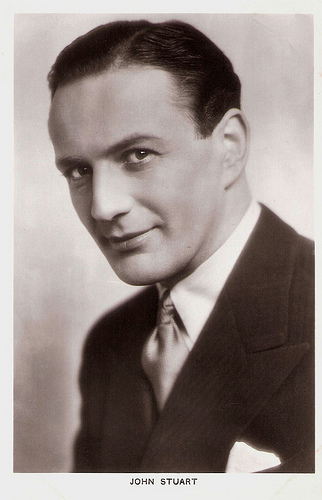
British postcard in the Picturegoer Series, London, no. 54e.
Quota Quickie
John Stuart starred with Benita Hume in the drama Men of Steel (George King, 1932). It was made at Nettlefold Studios under the so-called quota quickie system for distribution by United Artists. In 1927, The Cinematograph Films Act was designed to stimulate the declining British film industry. It introduced a requirement for British cinemas to show a quota of British films, for a duration of 10 years. The result of the act was the 'quota quickie', a low-cost, poor-quality film commissioned by American distributors operating in the UK purely to satisfy the quota requirements. During the 1930s Stuart appeared in a lot of these films. memorable are the drama The Lost Chord (Maurice Elvey, 1933) with Elizabeth Allan and Jack Hawkins, the comedy This Week of Grace Chord (Maurice Elvey, 1933) starring Gracie Fields and Henry Kendall, and Anglo-Italian aviation drama The Blue Squadron (George King, 1934) with Esmond Knight. Stuart co-starred with Fritz Kortner and Nils Asther in Abdul the Damned (Karl Grune, 1935), set in the Ottoman Empire in the years before the First World War where the Sultan and the Young Turks battle for power. He also worked often with director George Pearson, like in the thriller The Secret Voice (1936), and appeared in several parts of the long-running Old Mother Riley series. During the war years, Stuart’s parts became smaller or better said, he matured into character parts. He played a supporting part in the thriller Headline (John Harlow, 1944) with David Farrar as a crime reporter who searches for a mystery woman (Anne Crawford) who has witnessed a murder. Another example is the Gainsborough melodrama Madonna of the Seven Moons (Arthur Crabtree, 1945) starring Phyllis Calvert, Stewart Granger and Patricia Roc. In 1946 readers of the Daily Mail voted the film their third most popular British movie from 1939 to 1945. During the following decades he played government officials and police inspectors in B-films like the mystery The Ringer (Guy Hamilton, 1952) starring Herbert Lom, and the Science-fiction film Four Sided Triangle (Terence Fisher, 1953). Memorable are the war film Sink the Bismarck! (Lewis Gilbert, 1960) with Kenneth More, the Science-fiction film Village of the Damned (Wolf Rilla, 1960), and the suspense film Paranoiac (Freddie Francis, 1963) from Hammer Films and starring Janette Scott and Oliver Reed. Stuart now only played bit roles. His last part was a cameo in Superman (Richard Donner, 1978). In 1979, John Stuart died in London at the age of 81. He is buried in Brompton Cemetery, London. An accomplished writer, John Stuart penned his autobiography, Caught in the Act, in 1971. His son Jonathan Croall is writing a book about the screen idols of the 1920s, including John Stuart.
Trailer The Pleasure Garden (1925). Source: BFIfilms (YouTube).
Scene from Number Seventeen (1932). Source: TheLadyPhantom (YouTube).
Sources: Hal Erickson (AllMovie), Wikipedia and

British postcard in the Colourgraph Series, London, no. C. 237. Photo: Mannell.

British postcard in the Picturegoer Series, London, no. 54c.
Instant Star
John Stuart was born John Alfred Louden Croall in Edinburgh, Scotland in 1898. He began his stage and screen career directly after World War I service in The Black Watch. He made his film debut in the drama The Lights of Home (Fred Paul, 1920). Other silent films were the drama If Four Walls Told (Fred Paul, 1922) starring Lillian Hall-Davis, the comedy The School for Scandal (Bertram Phillips, 1923) with Queenie Thomas, and the comedy We Women (W.P. Kellino, 1925). Stuart was a very popular leading man in British silent films, though it's hard to gauge that popularity since many of his best films of the 1920s, such as A Sporting Double (Arthur Rooke, 1923), Constant Hot Water (George A. Cooper, 1924) and The Tower of London (Maurice Elvey, 1926) with Isobel Elsom, are either inaccessible or non-existent. He appeared in a silent film directed by Alfred Hitchcock. The Pleasure Garden (1925) was Hitchcock’s directorial debut. Based on a novel by Oliver Sandys, the film is about two chorus girls at the Pleasure Garden Theatre in London and their troubled relationships. Glamorous American star Virginia Valli played the lead. The film was shot in Italy and Germany in 1925 and shown to the British press in March 1926. But it was not officially released in the UK until 1927, after Hitchcock's film The Lodger: A Story of the London Fog became a massive hit in February 1927. Stuart worked several times with director Maurice Elvey. Very popular was their World War I drama Mademoiselle from Armentieres (Maurice Elvey, 1926), featuring Estelle Brody. The film opened in London in September 1926 and was still playing in cinemas around the country until well into 1927. It was reportedly the most profitable British film of 1926 and made an instant star of Brody. The two stars were reunited in the drama Hindle Wakes (Maurice Elvey, 1927), which skilful use of location is considered to give the film a documentary realism feel very unusual in British films of the period. Brody and Stuart co-starred again in Mademoiselle Parley Voo (Maurice Elvey, 1928), a sequel to Mademoiselle from Armentieres, and equally successful. By the way, both films refer to the popular First World War song Mademoiselle from Armentières.

Lillian Hall-Davis German postcard by Ross Verlag, Berlin, no. 1479/2, 1927-1928. Photo: Ufa.

Queenie Thomas. British postcard in the series Screen Plays. Photo: Bertram Phillips.
Number Seventeen
John Stuart’s first sound film, Kitty (Victor Saville, 1929) was another successful production. Kitty was initially planned and filmed as a silent, but on its original completion director Saville decided to reshoot the latter part with sound. As no suitable facilities were yet available in Britain, Saville, Estelle Brody and Stuart travelled to New York to shoot the new sequences at RKO Studios. The film was released in the form of a silent which switched to sound after the half-way point. Stuart’s next film, Atlantic (1929) was one of the first British films made with the soundtrack optically recorded on the film (sound-on-film). Atlantic was directed and produced by Ewald André Dupont. Three versions were made, an English and a German language version, Atlantik, which were shot simultaneously, and later a French version was made. In England, Atlantic was released in both sound and silent prints. The film was originally made as Titanic but after lawsuits it was renamed Atlantic. The White Star Line, which owned the RMS Titanic, was still in operation at the time. The final scene of the film was filmed as a shot of the liner sinking but it was cut at the last minute as it was feared it would upset Titanic survivors. Then Stuart worked for a second time with Alfred Hitchcock, although indirectly. Elstree Calling (1930) is a lavish musical film revue directed by Andre Charlot, Jack Hulbert, Paul Murray, and Hitchcock at Elstree Studios. It was Britain's answer to the Hollywood revues, such as Paramount on Parade (Dorothy Arzner et al, 1930) and The Hollywood Review of 1929 (Charles Reisner, 1929). Stuart was not appearing in the segments directed by Hitchcock. They really worked together again on Number Seventeen (Alfred Hitchcock, 1932), in which Stuart played the lead. The film is about a group of criminals who committed a jewel robbery and put their money in an old house over a railway leading to the English Channel, the film's title being derived from the house's street number. An outsider stumbles onto this plot and intervenes with the help of a neighbour, a police officer's daughter. On its initial release, audiences reacted to Number Seventeen with confusion and disappointment. Stuart then played Sir Henry Baskerville in the mystery The Hound of the Baskervilles (Gareth Gundrey, 1932), based on the novel by Arthur Conan Doyle and scripted by Edgar Wallace. He was the co-star of Brigitte Helm in The Mistress of Atlantis (Georg Wilhelm Pabst, 1932), the English language version of the German-French adventure and fantasy film L'Atlantide/Die Herrin von Atlantis (Georg Wilhelm Pabst, 1932) based on the novel L'Atlantide by Pierre Benoît.

British postcard in the Picturegoer Series, London, no. 54e.

British postcard in the Picturegoer Series, London, no. 54e.
Quota Quickie
John Stuart starred with Benita Hume in the drama Men of Steel (George King, 1932). It was made at Nettlefold Studios under the so-called quota quickie system for distribution by United Artists. In 1927, The Cinematograph Films Act was designed to stimulate the declining British film industry. It introduced a requirement for British cinemas to show a quota of British films, for a duration of 10 years. The result of the act was the 'quota quickie', a low-cost, poor-quality film commissioned by American distributors operating in the UK purely to satisfy the quota requirements. During the 1930s Stuart appeared in a lot of these films. memorable are the drama The Lost Chord (Maurice Elvey, 1933) with Elizabeth Allan and Jack Hawkins, the comedy This Week of Grace Chord (Maurice Elvey, 1933) starring Gracie Fields and Henry Kendall, and Anglo-Italian aviation drama The Blue Squadron (George King, 1934) with Esmond Knight. Stuart co-starred with Fritz Kortner and Nils Asther in Abdul the Damned (Karl Grune, 1935), set in the Ottoman Empire in the years before the First World War where the Sultan and the Young Turks battle for power. He also worked often with director George Pearson, like in the thriller The Secret Voice (1936), and appeared in several parts of the long-running Old Mother Riley series. During the war years, Stuart’s parts became smaller or better said, he matured into character parts. He played a supporting part in the thriller Headline (John Harlow, 1944) with David Farrar as a crime reporter who searches for a mystery woman (Anne Crawford) who has witnessed a murder. Another example is the Gainsborough melodrama Madonna of the Seven Moons (Arthur Crabtree, 1945) starring Phyllis Calvert, Stewart Granger and Patricia Roc. In 1946 readers of the Daily Mail voted the film their third most popular British movie from 1939 to 1945. During the following decades he played government officials and police inspectors in B-films like the mystery The Ringer (Guy Hamilton, 1952) starring Herbert Lom, and the Science-fiction film Four Sided Triangle (Terence Fisher, 1953). Memorable are the war film Sink the Bismarck! (Lewis Gilbert, 1960) with Kenneth More, the Science-fiction film Village of the Damned (Wolf Rilla, 1960), and the suspense film Paranoiac (Freddie Francis, 1963) from Hammer Films and starring Janette Scott and Oliver Reed. Stuart now only played bit roles. His last part was a cameo in Superman (Richard Donner, 1978). In 1979, John Stuart died in London at the age of 81. He is buried in Brompton Cemetery, London. An accomplished writer, John Stuart penned his autobiography, Caught in the Act, in 1971. His son Jonathan Croall is writing a book about the screen idols of the 1920s, including John Stuart.
Trailer The Pleasure Garden (1925). Source: BFIfilms (YouTube).
Scene from Number Seventeen (1932). Source: TheLadyPhantom (YouTube).
Sources: Hal Erickson (AllMovie), Wikipedia and
Published on July 02, 2013 23:00
Paul van Yperen's Blog
- Paul van Yperen's profile
- 13 followers
Paul van Yperen isn't a Goodreads Author
(yet),
but they
do have a blog,
so here are some recent posts imported from
their feed.



